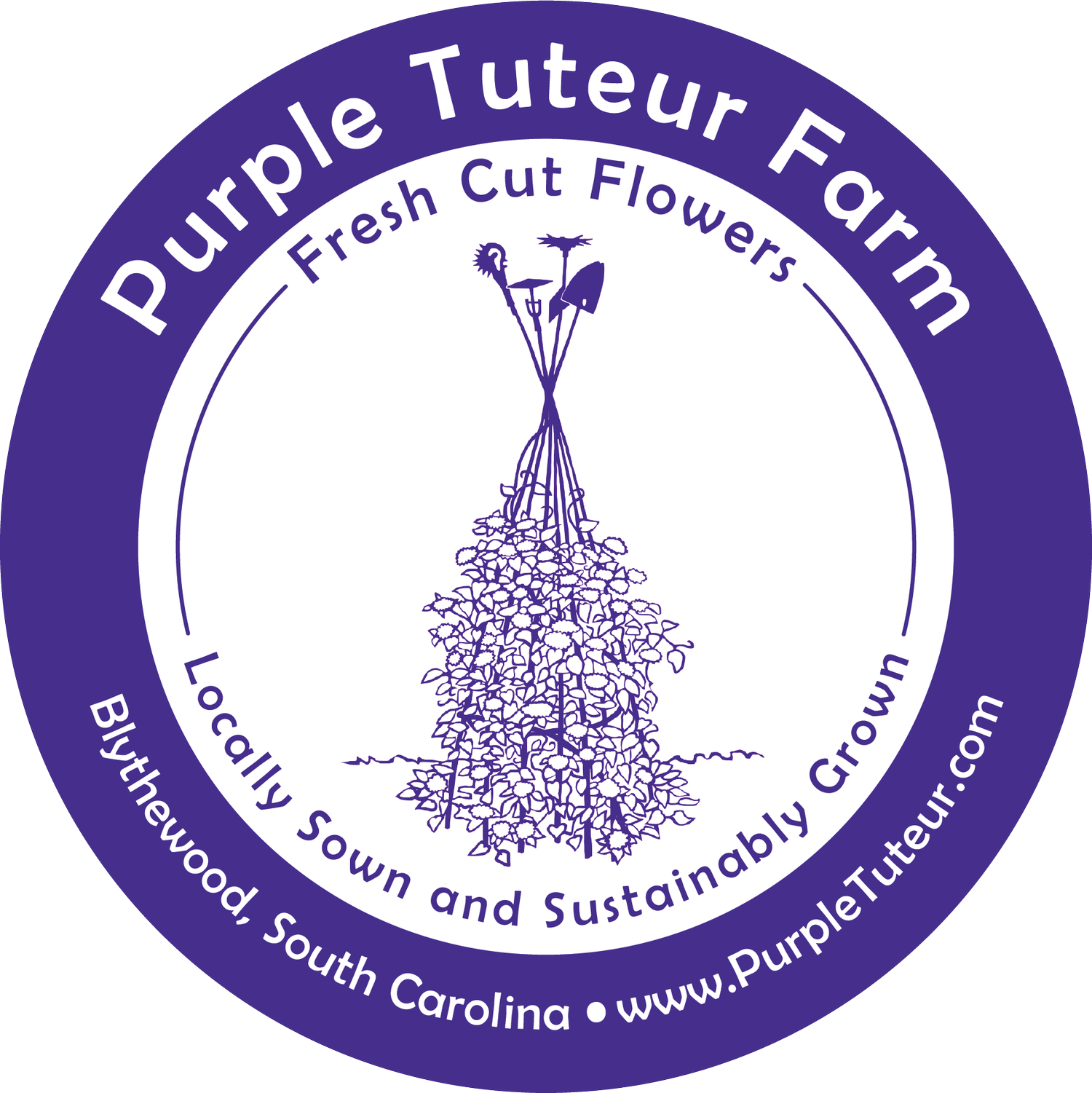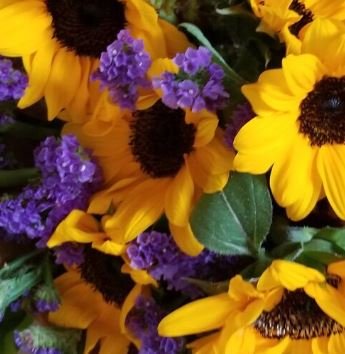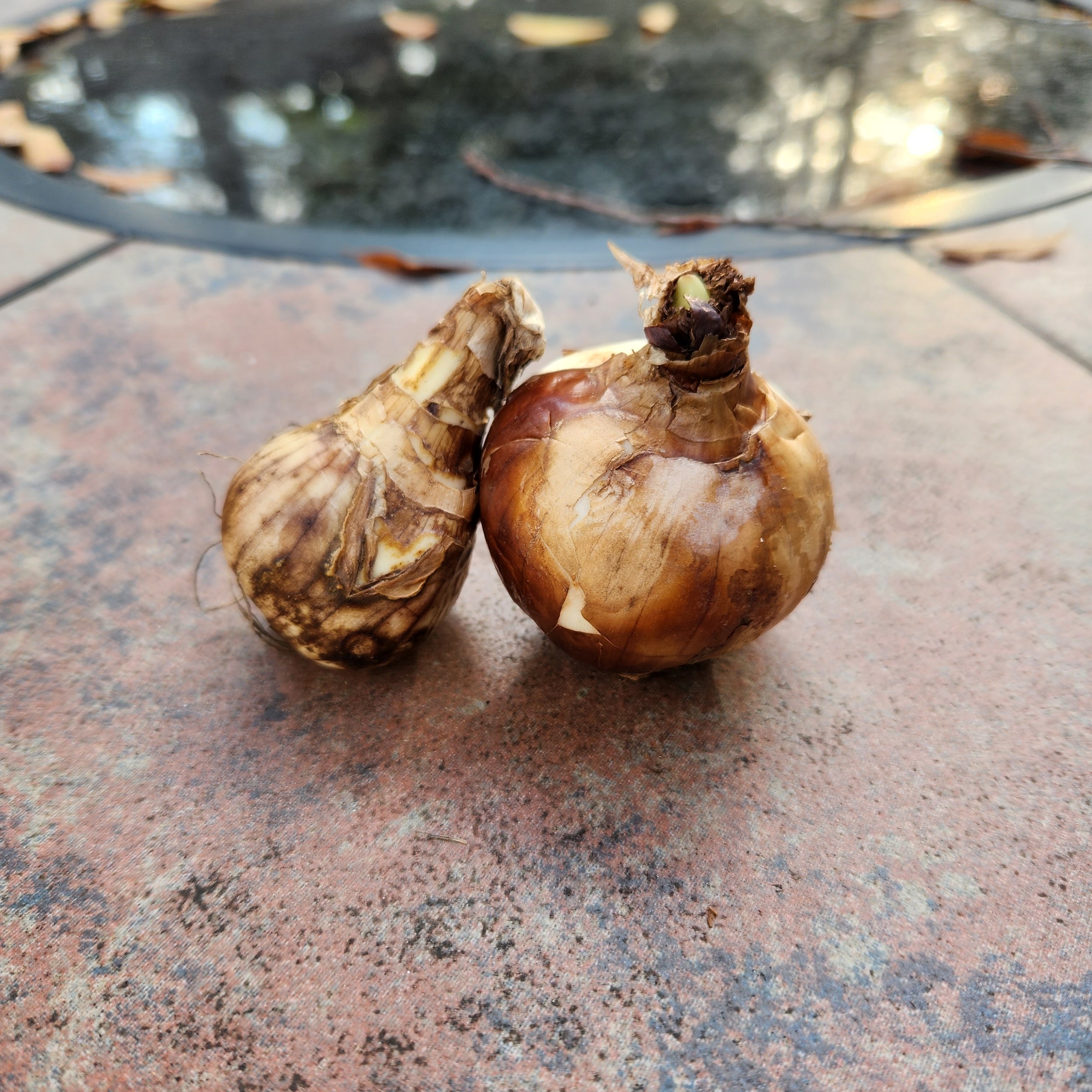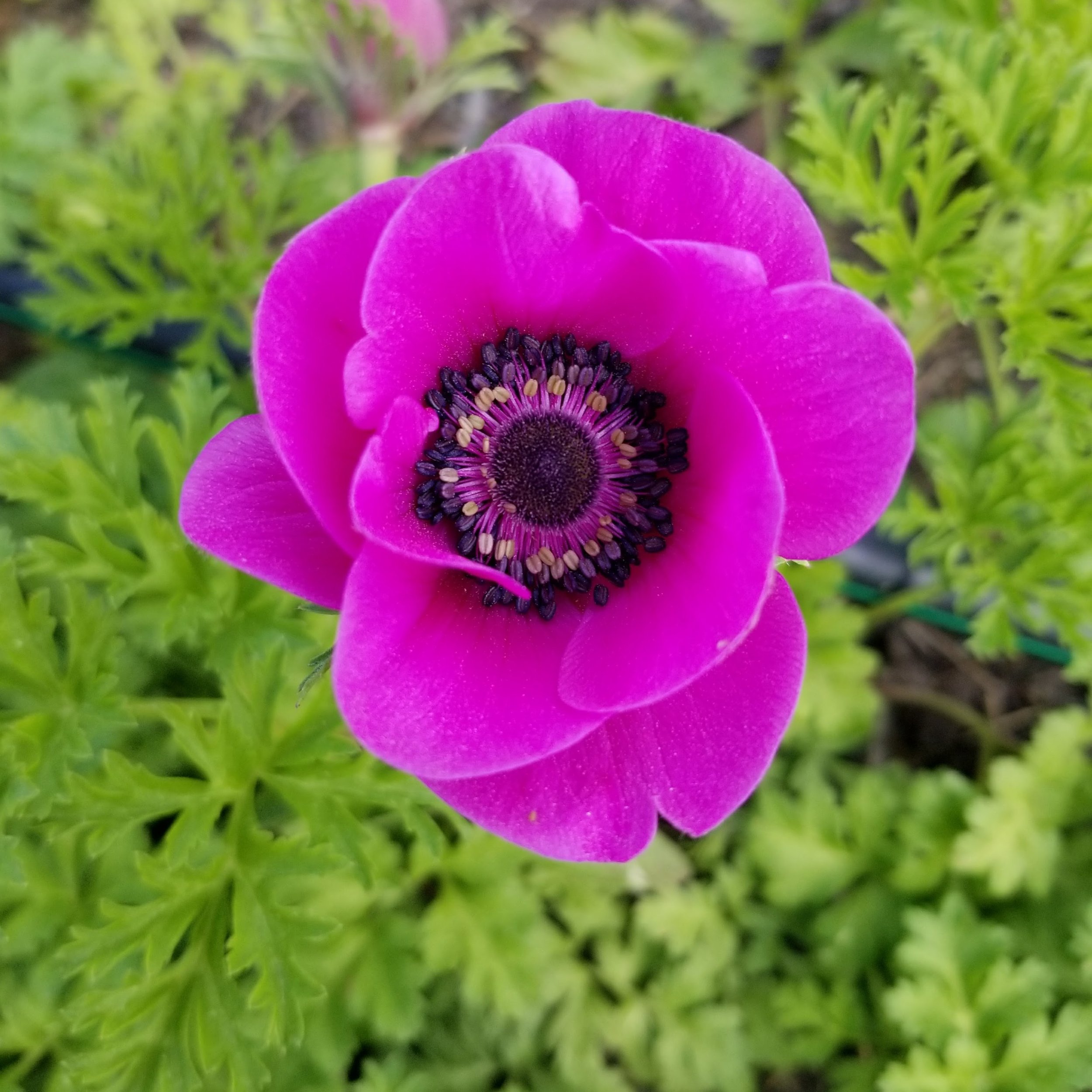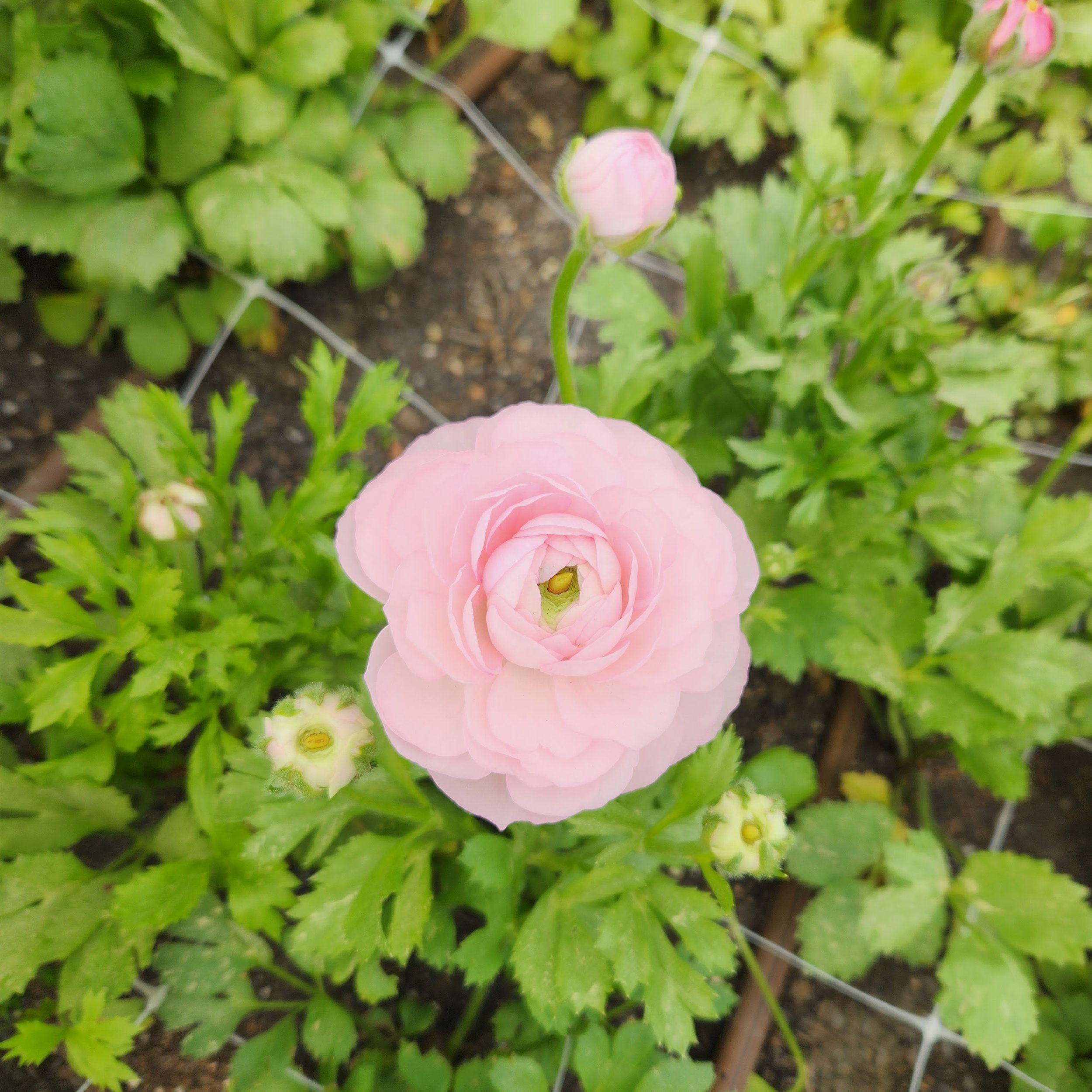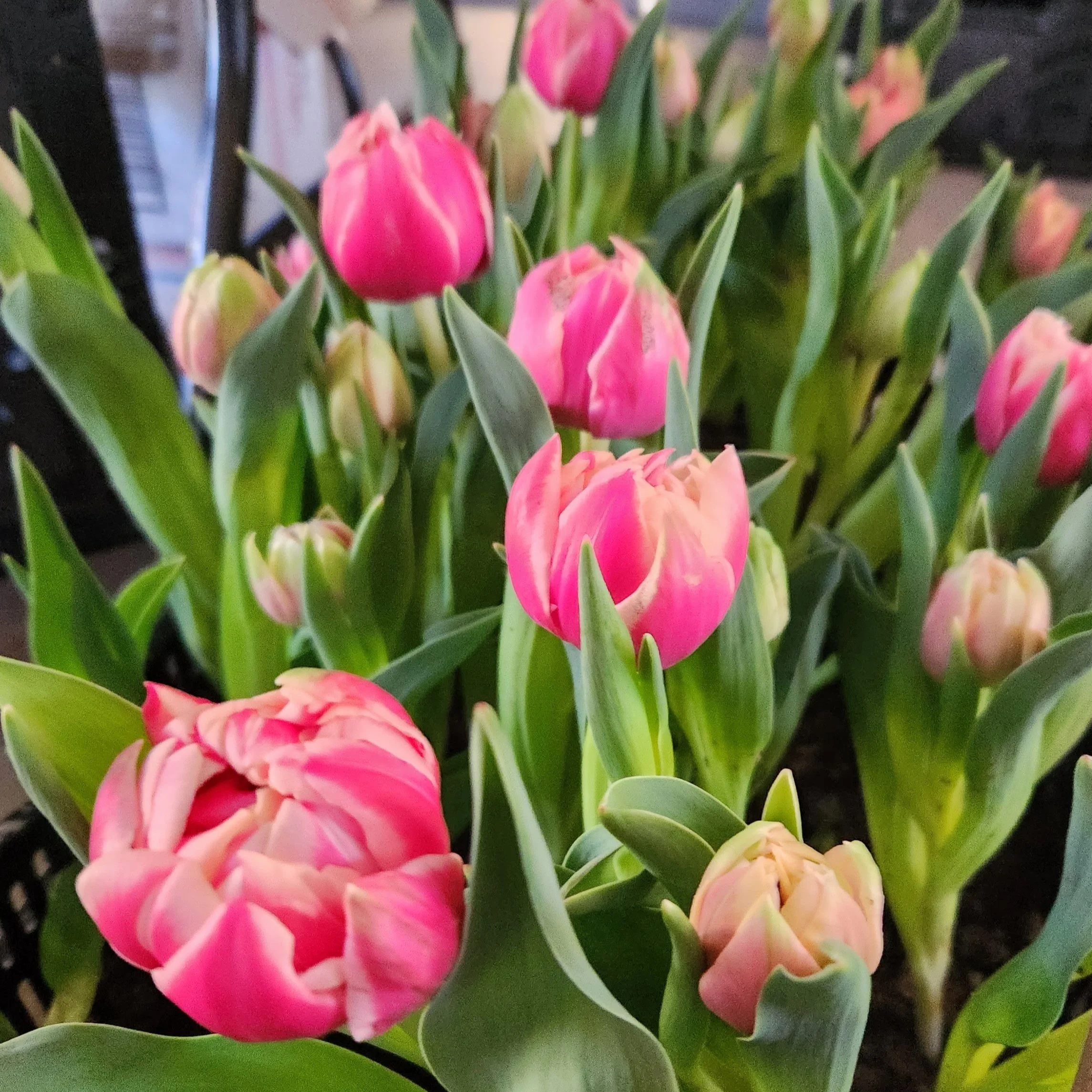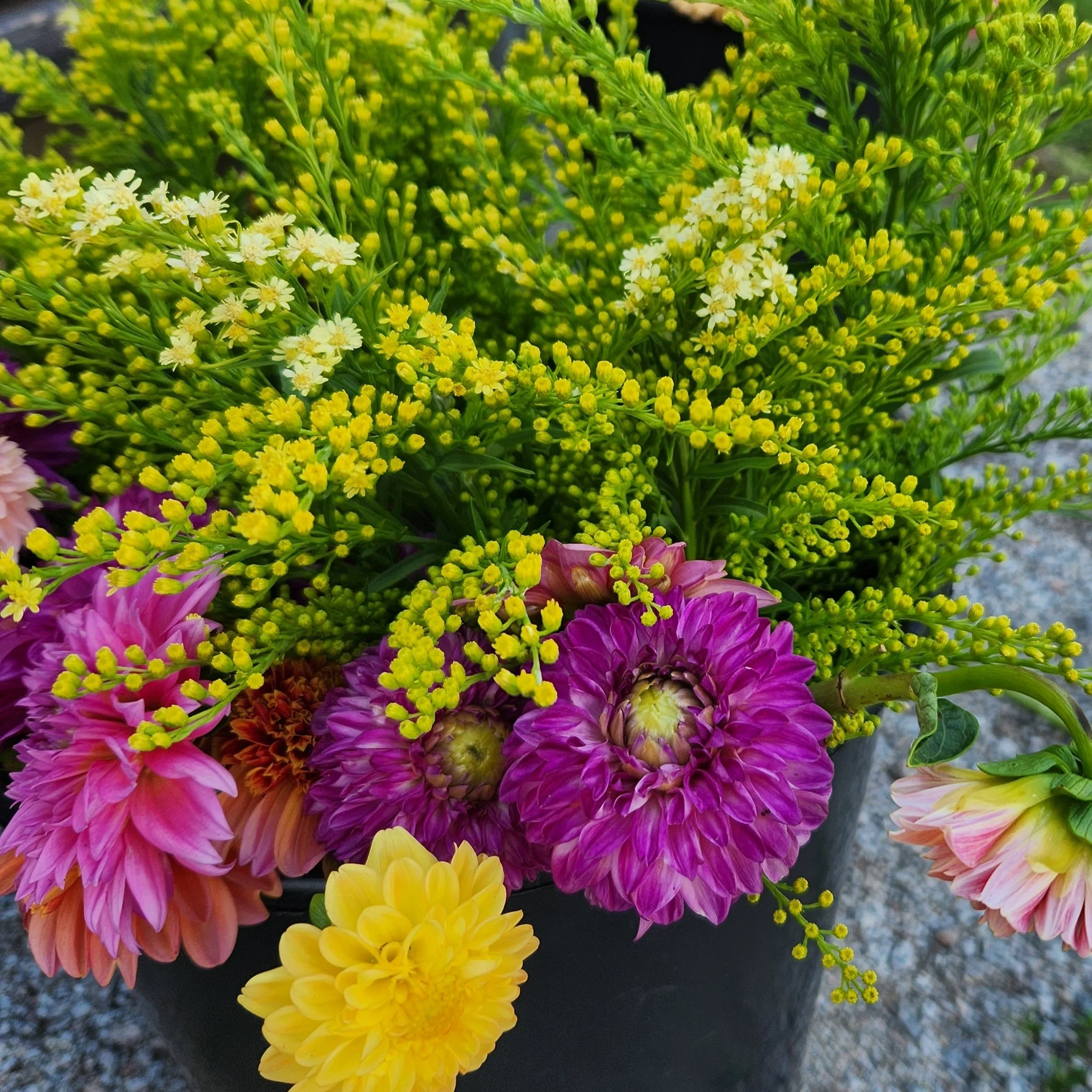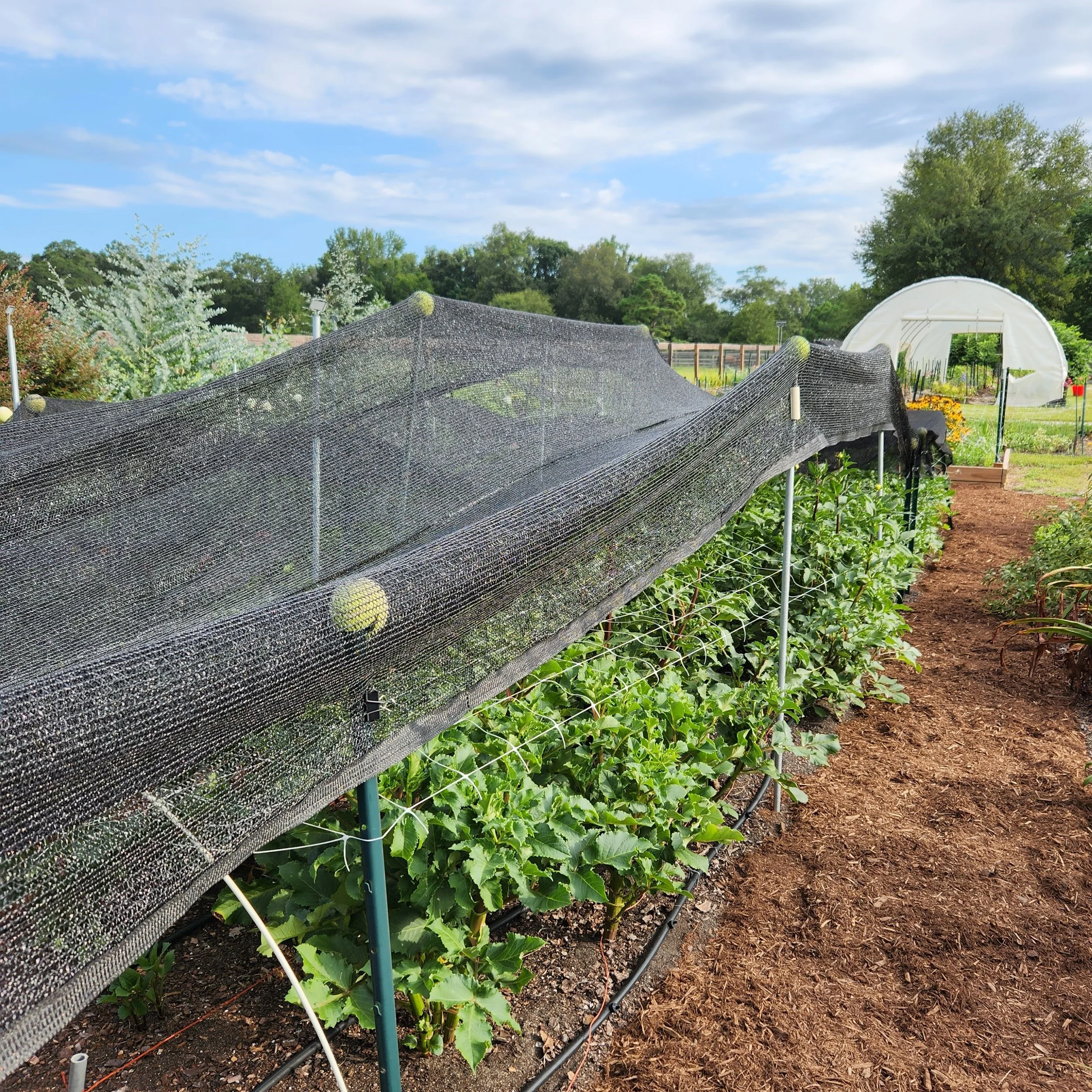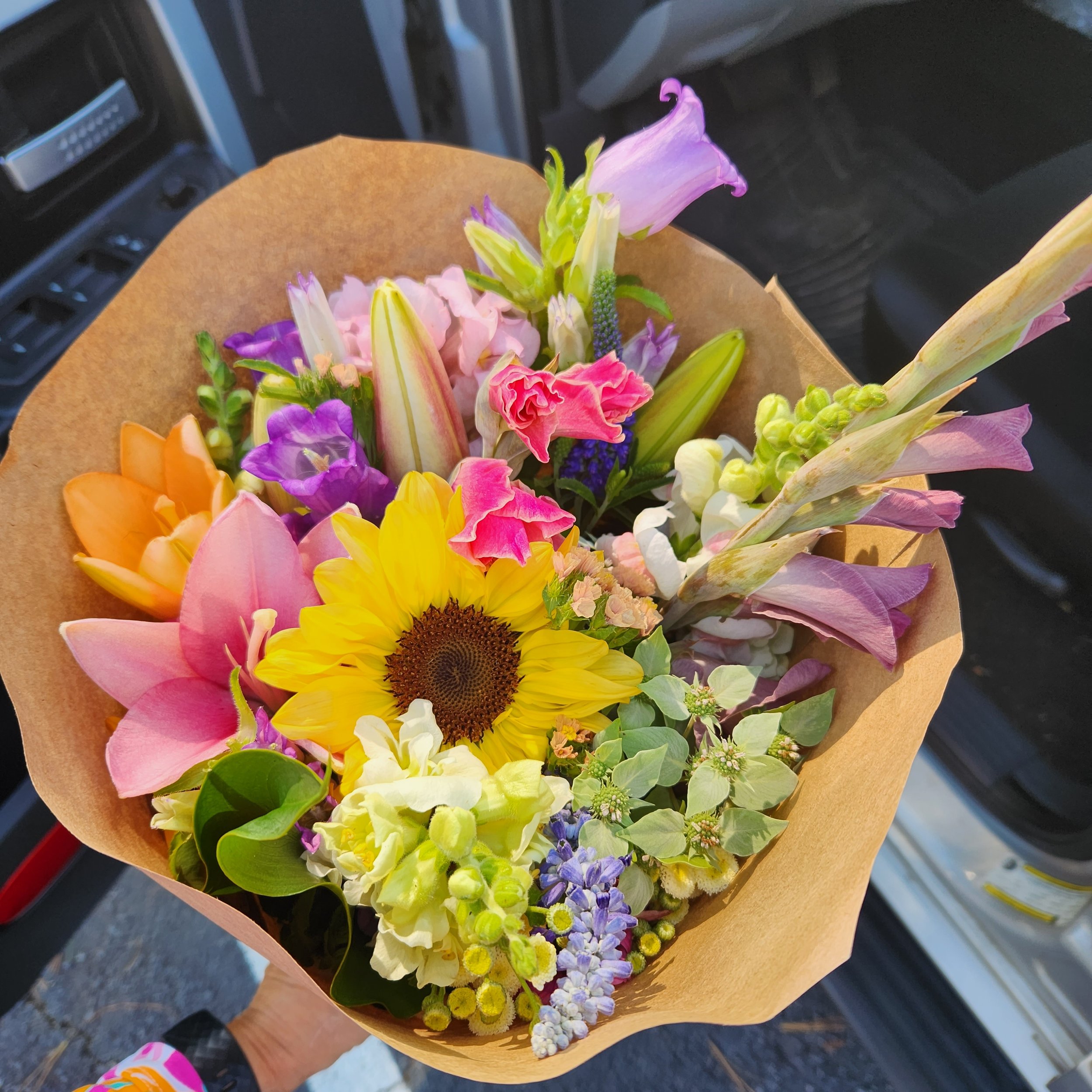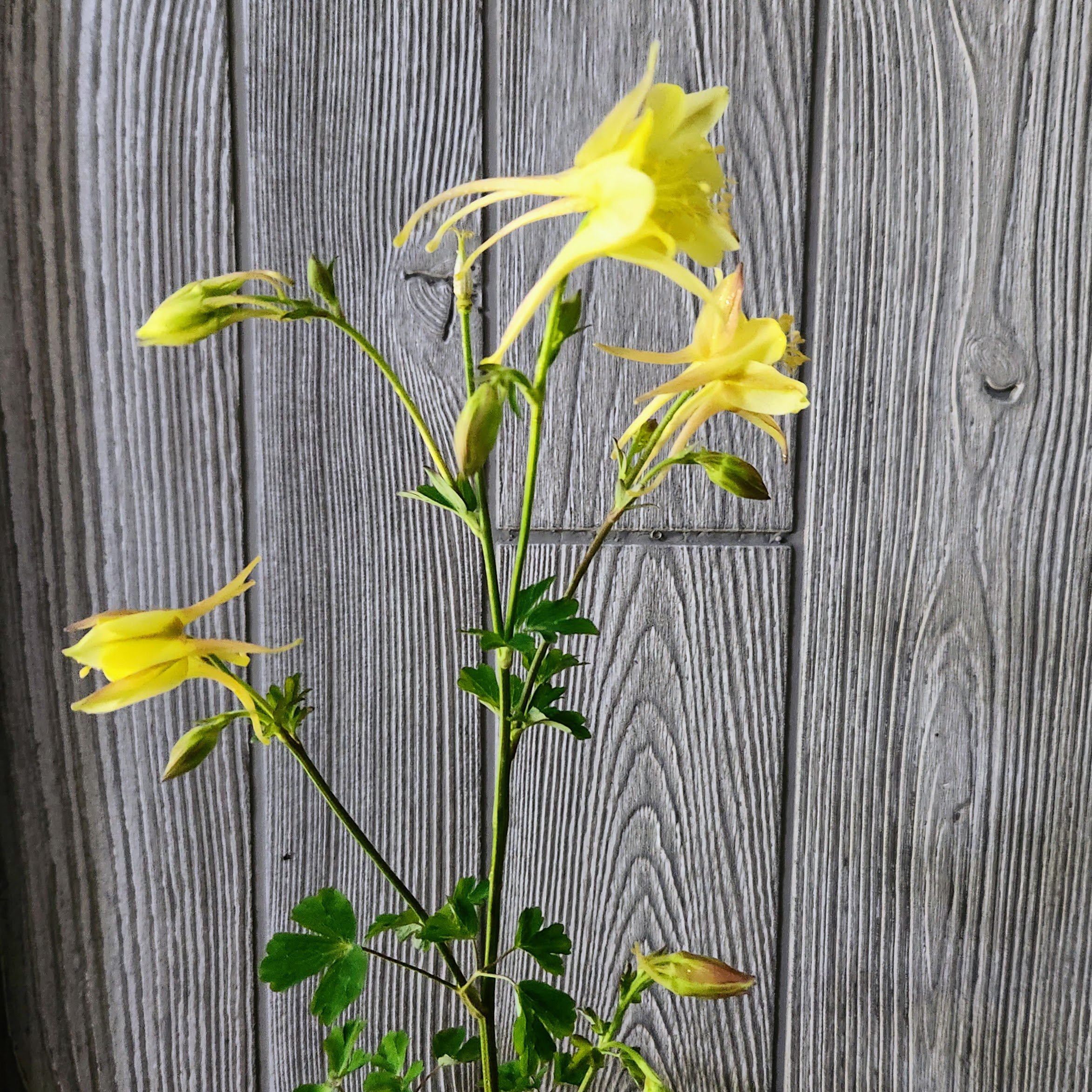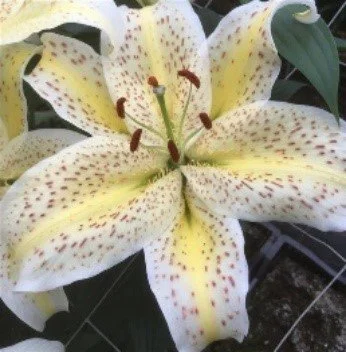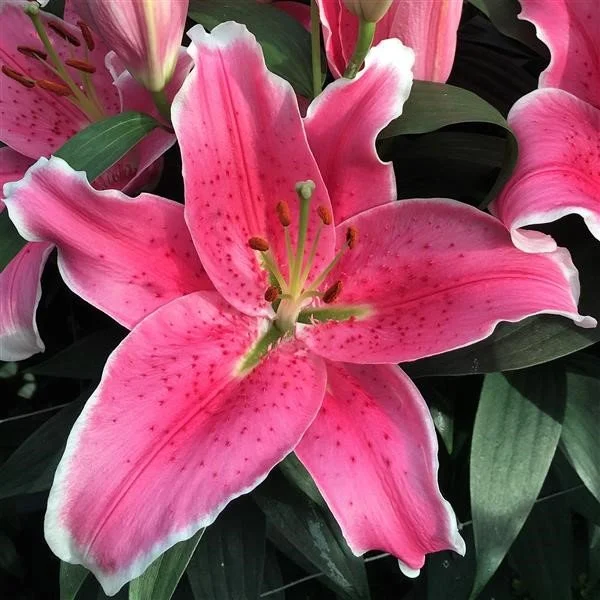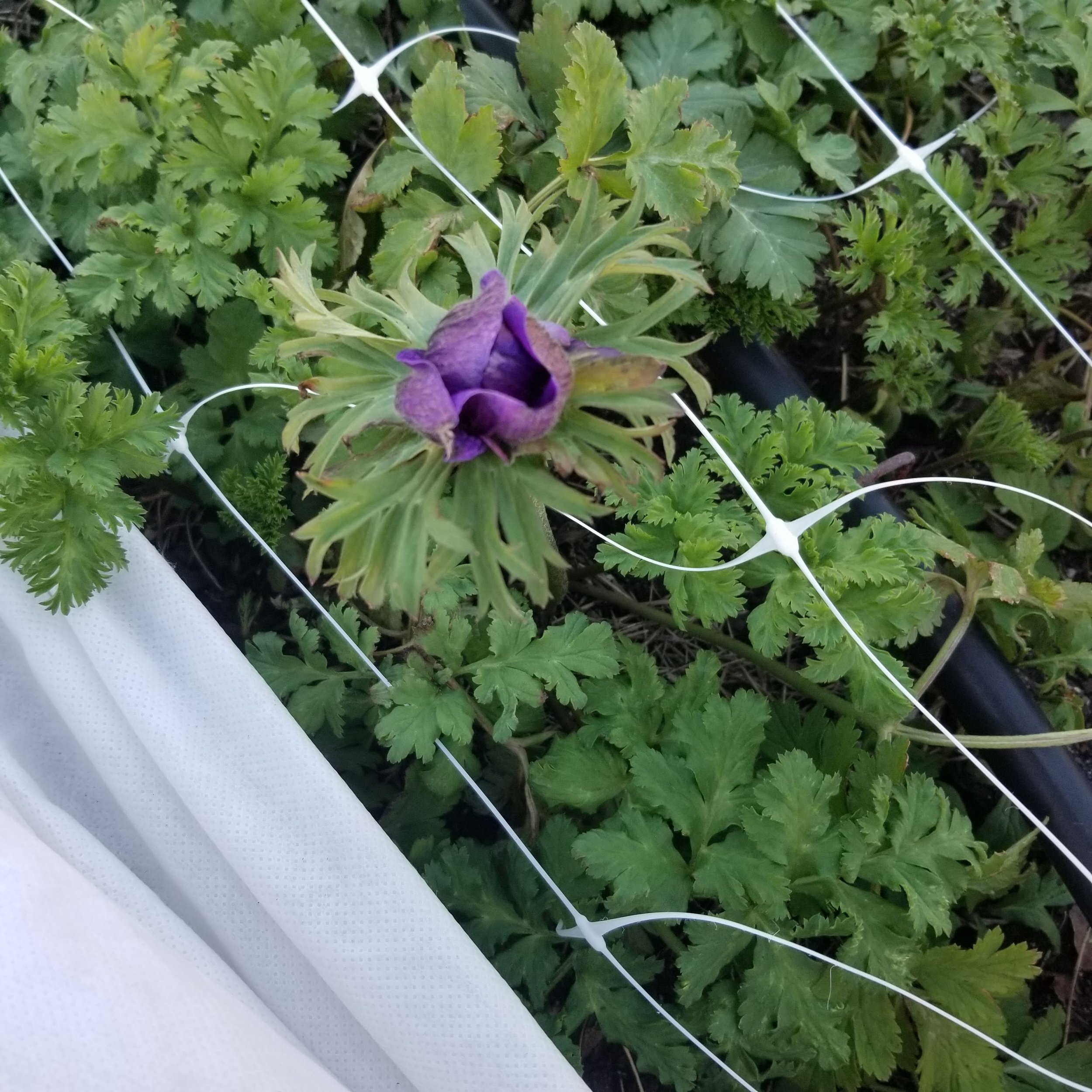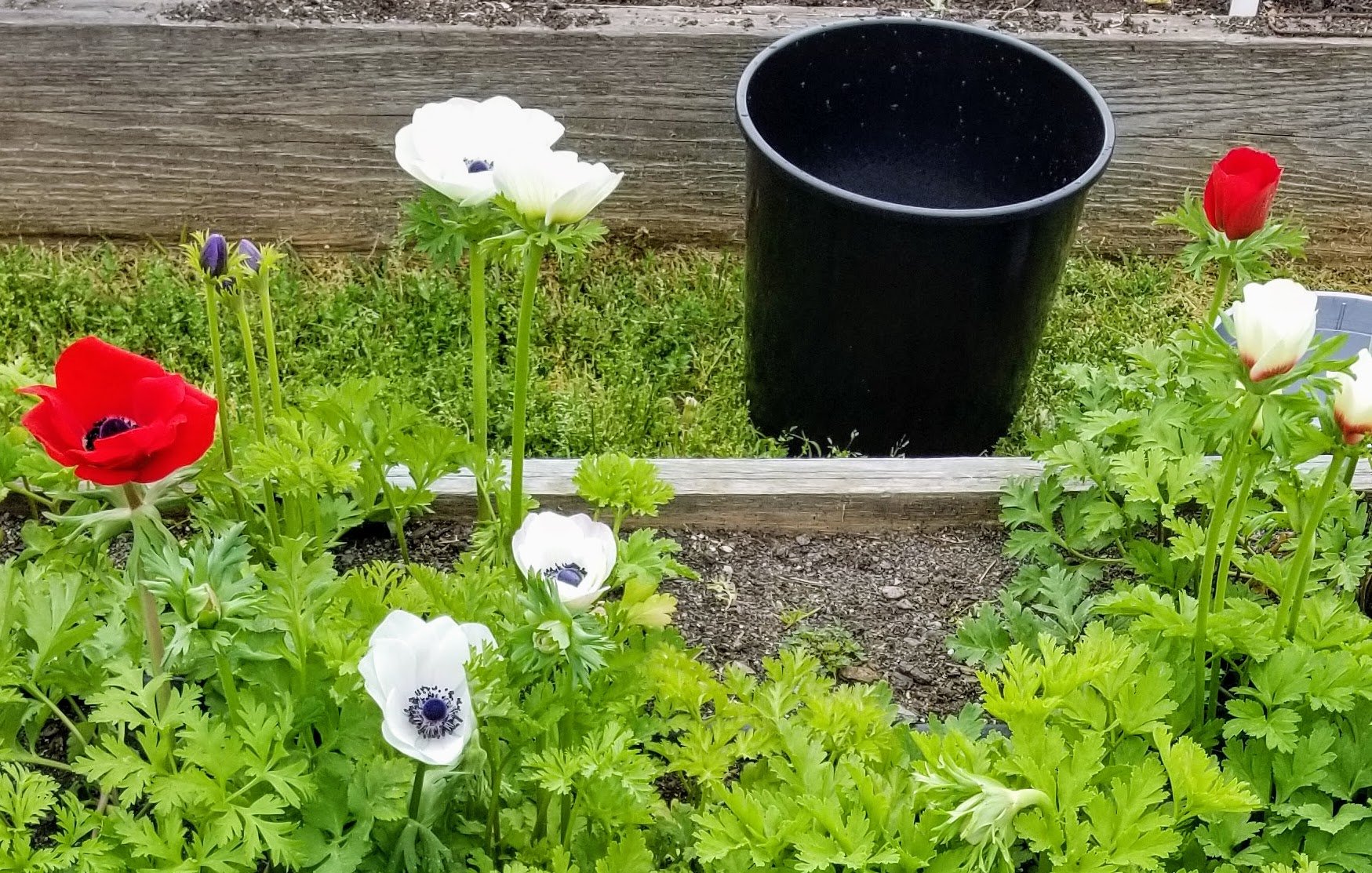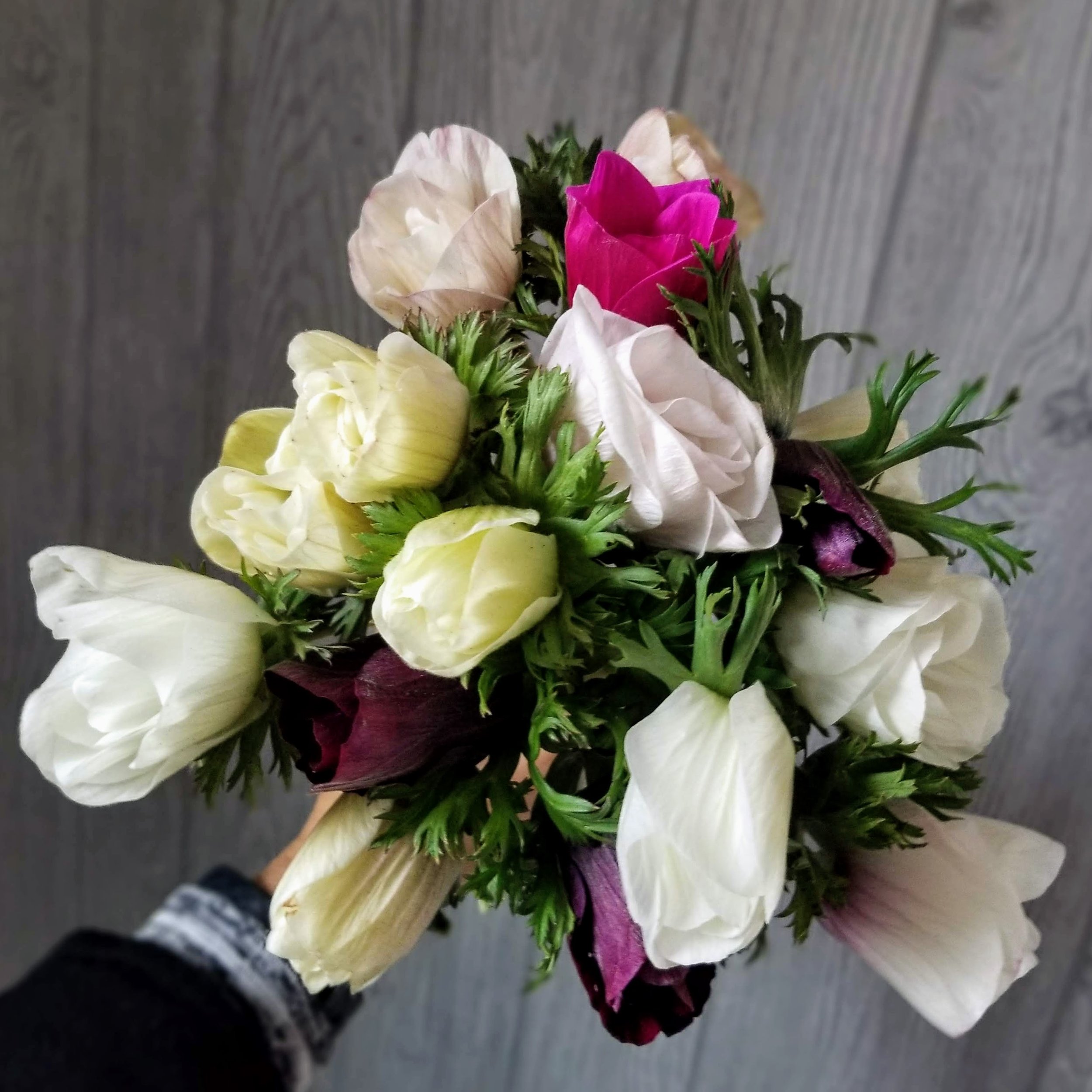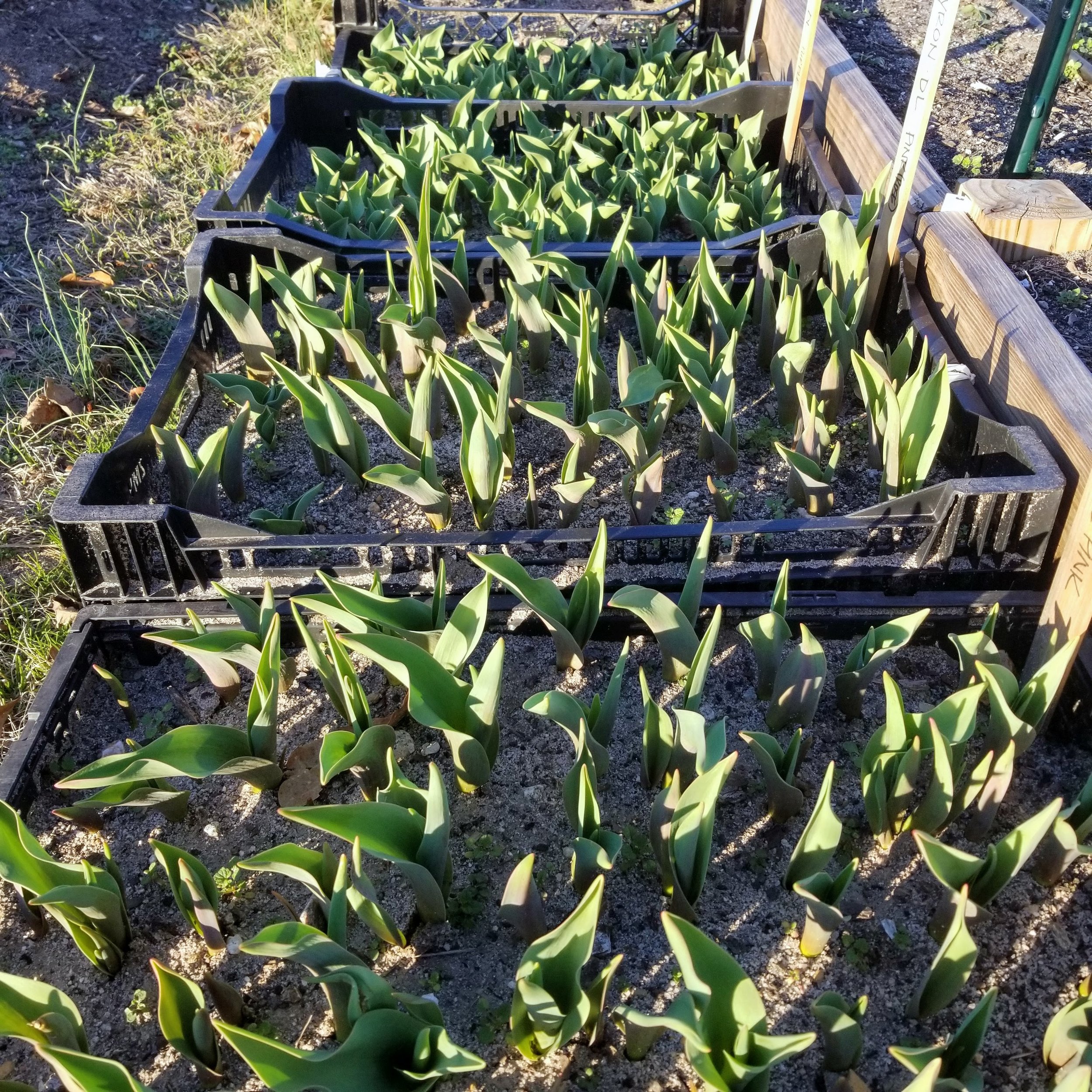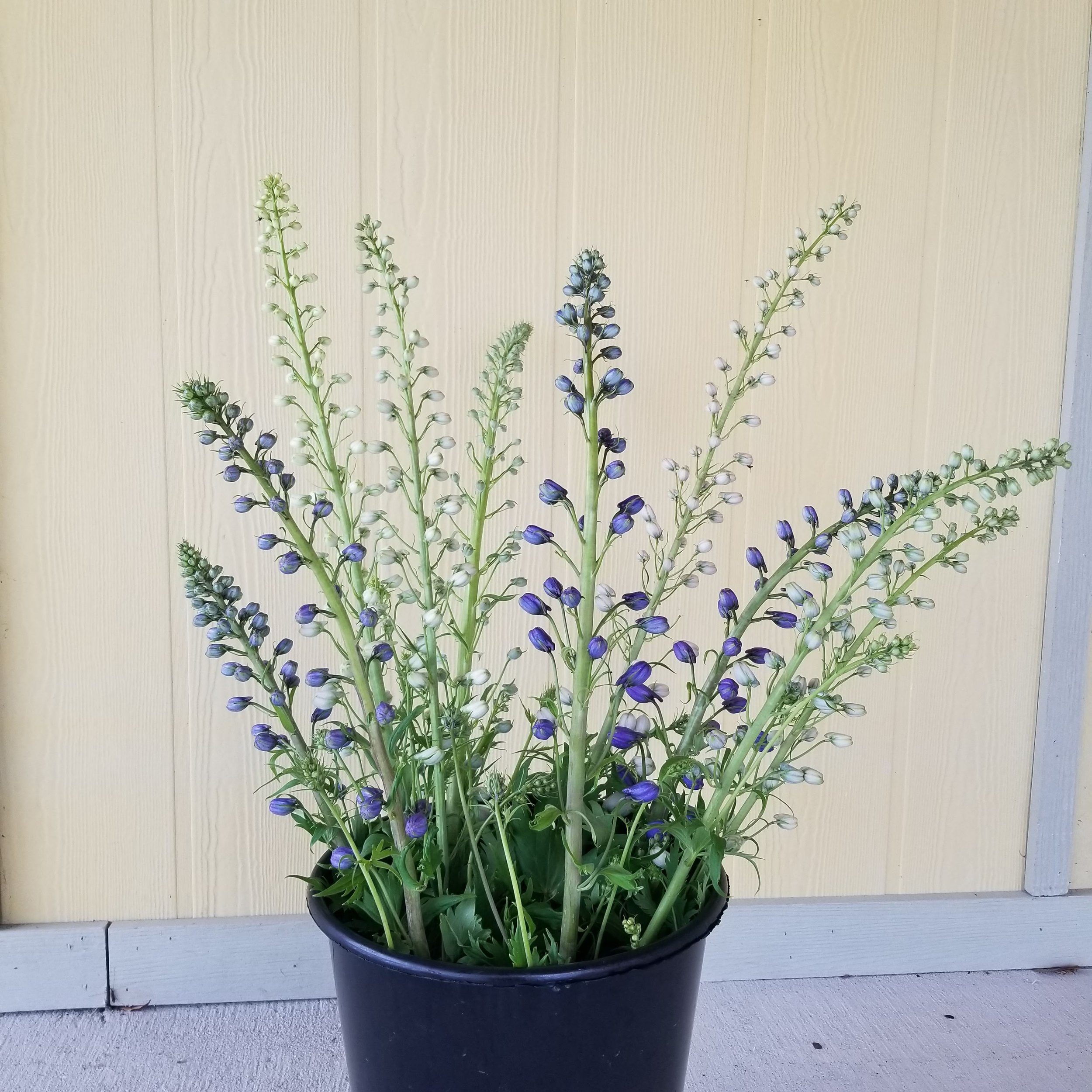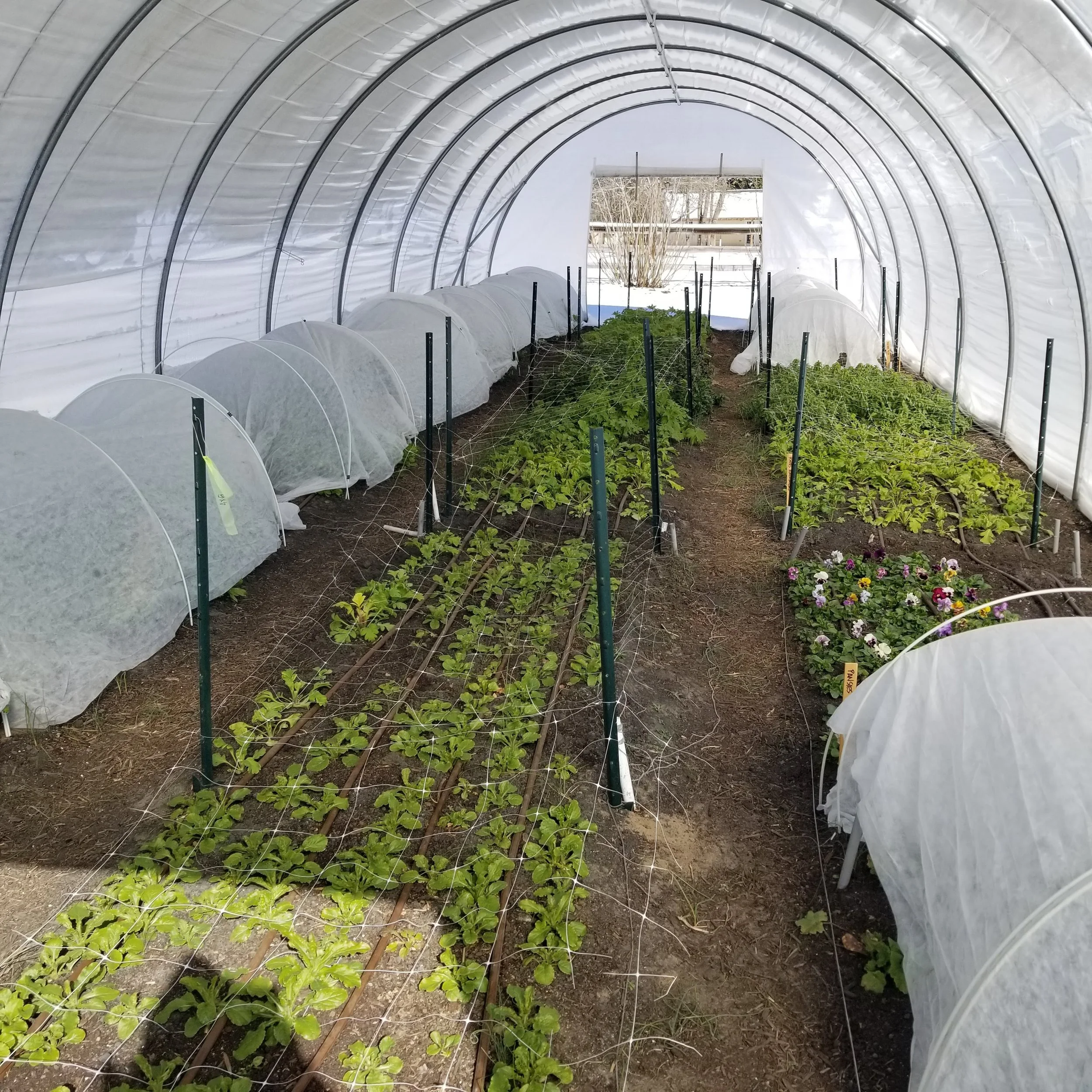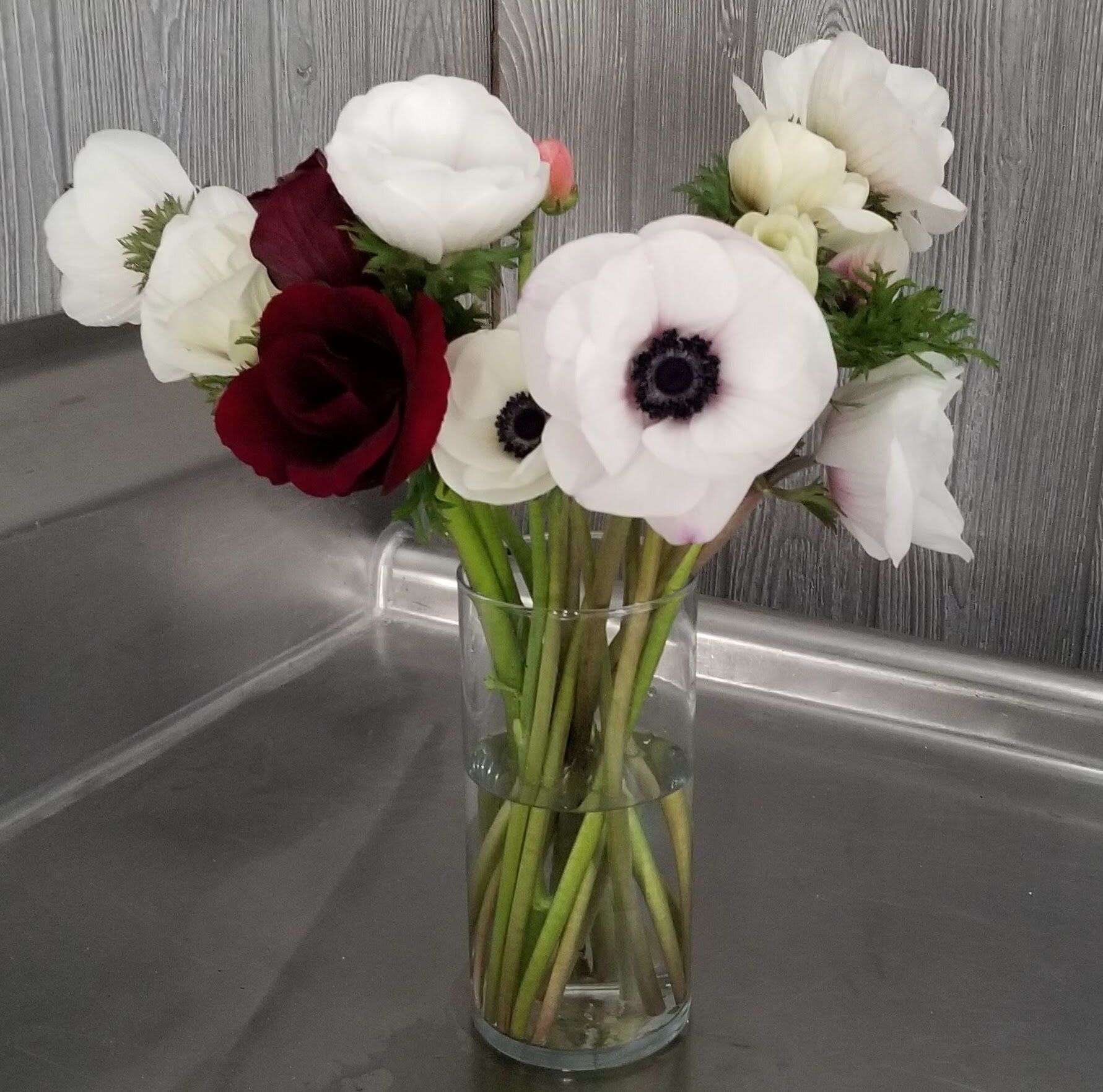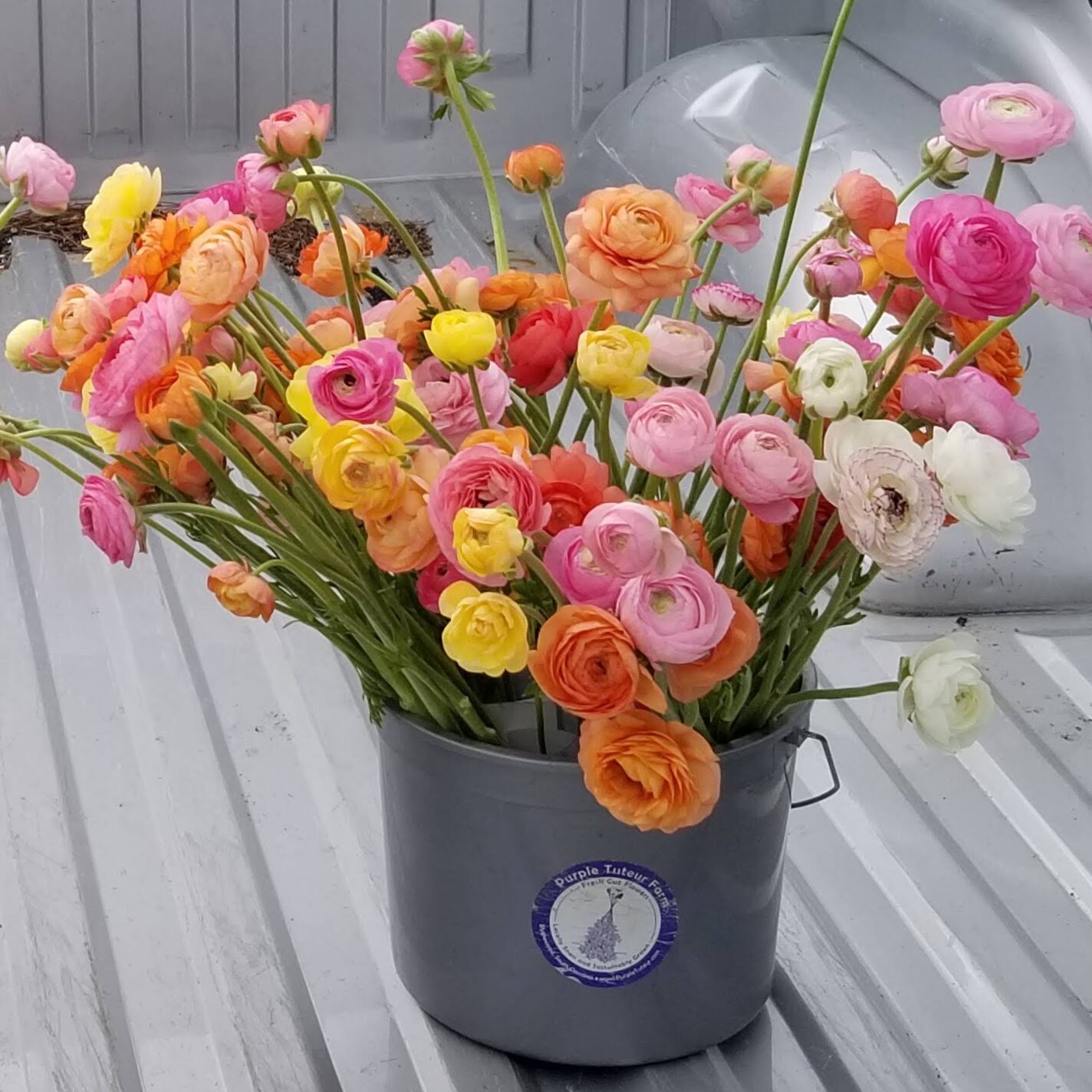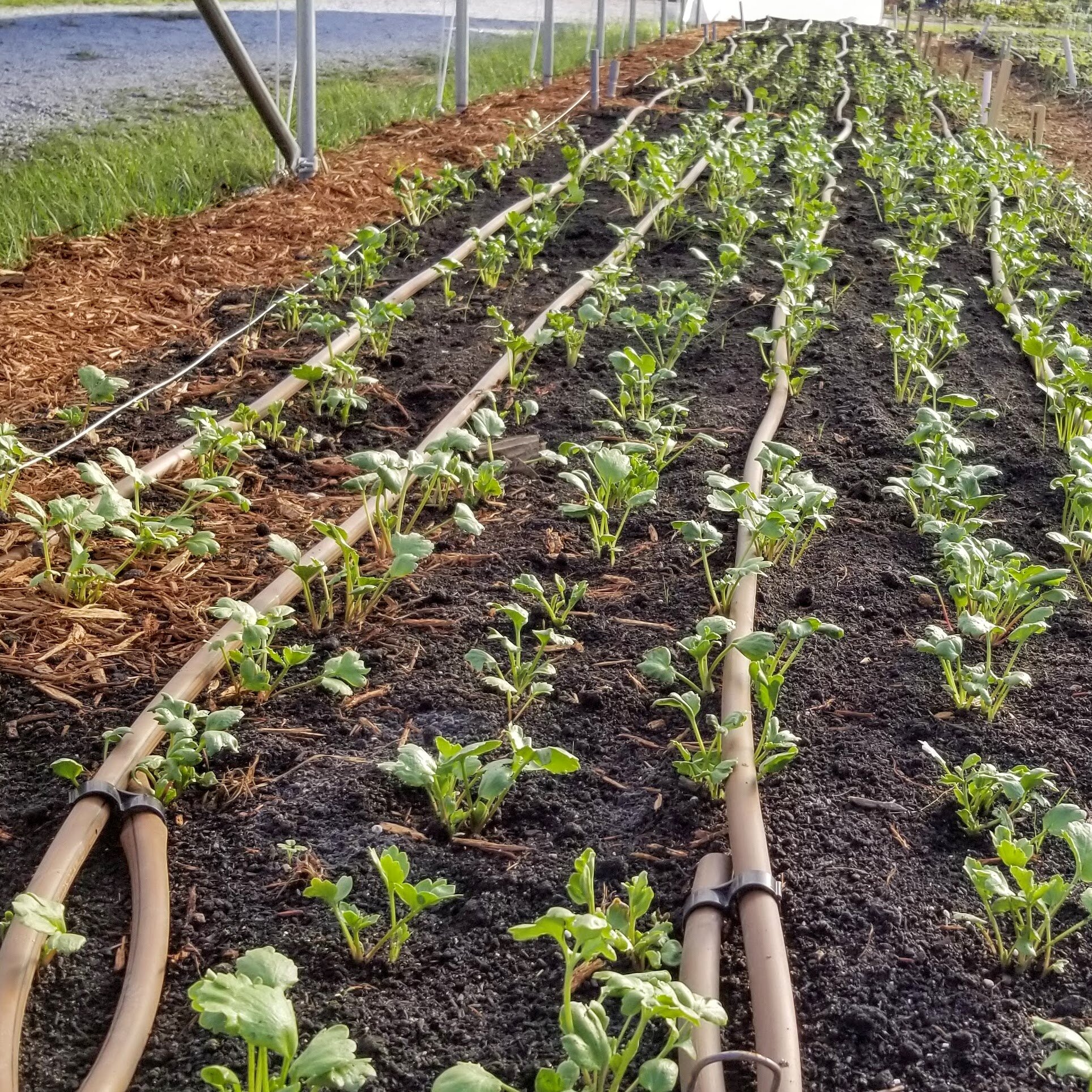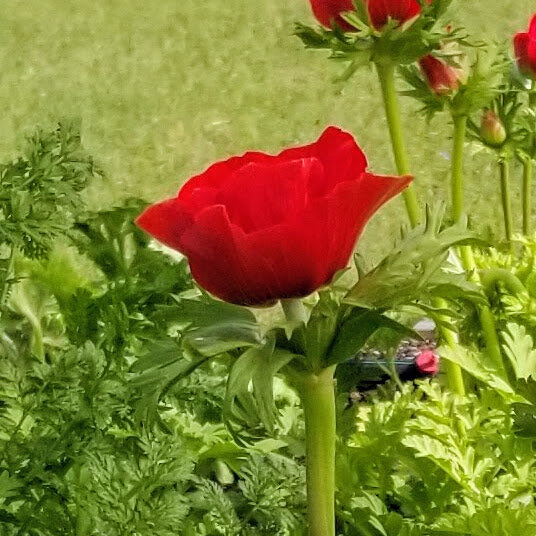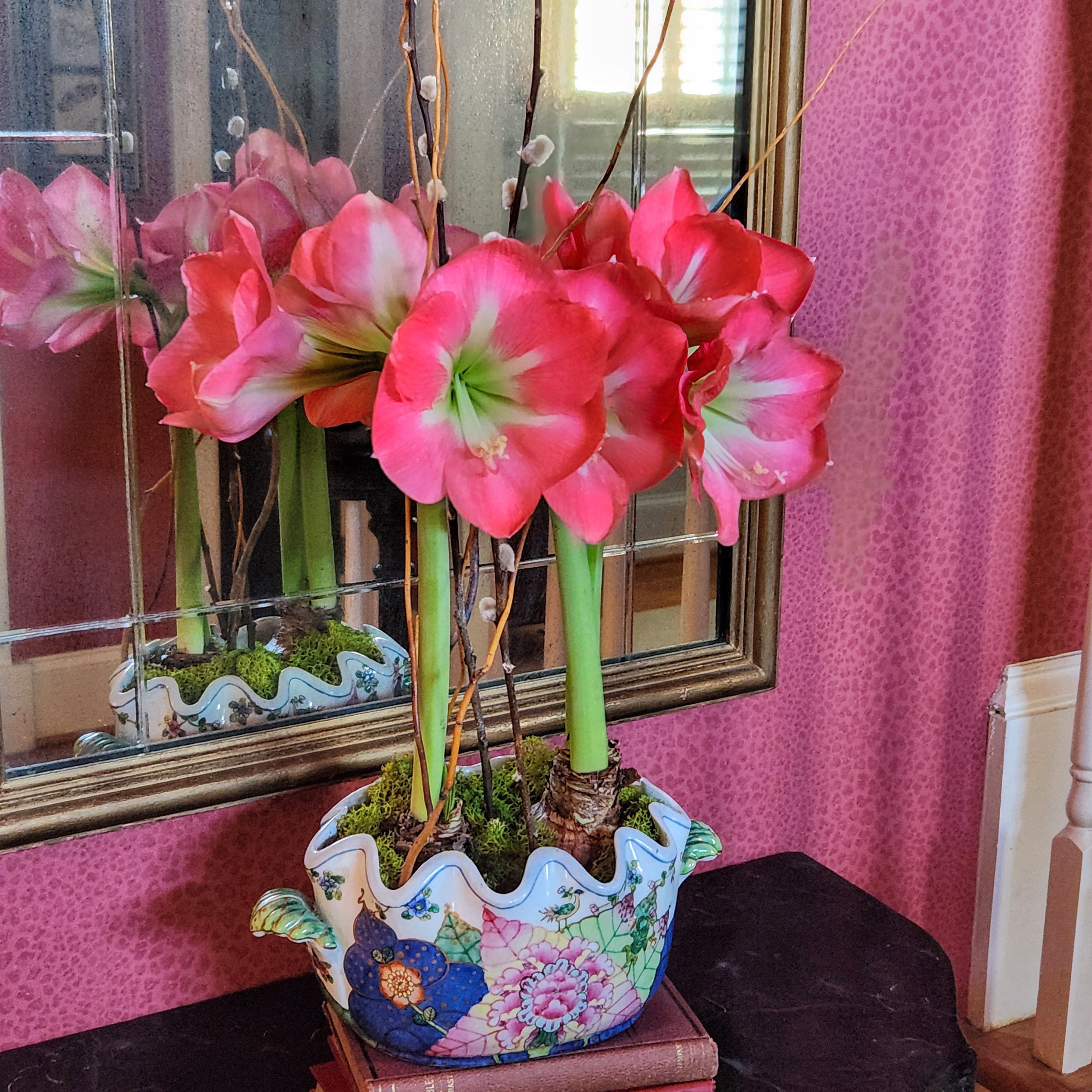
Amaryllis Care
Amaryllis Care Guide: How to Grow for Blooms Indoors and Outdoors
Amaryllis are treasured for their ability to produce large, vibrant flowers indoors during the coldest months of winter. Their low-maintenance care and potential for reblooming make them a favorite among indoor gardeners. Follow this guide to enjoy the beauty of amaryllis year after year indoors, or to transition them outdoors to enjoy in your garden here in Columbia.
Amaryllis Cape Horn
Choosing Your Amaryllis Bulbs
Look for firm, unblemished bulbs, similar to how you would choose an onion. Larger bulbs produce more stems and flowers. For a more impressive display, choose the largest bulbs you can find. The flowers are already formed in the bulb when you receive them, so larger bulbs will have more and larger flowers.
While red and white varieties are the most common, amaryllis is also available in shades of pink, burgundy, orange, yellow, and even green.
Select bulbs from the southern hemisphere (sometimes referred to as “Christmas Blooming”) if you want them to bloom for the holidays, or as fast as possible (4-6 weeks). Bulbs from the northern hemisphere (sometimes called “shelf stable”) will bloom after the holidays, since they are going to take longer to acclimate to the warmth of your home. Typically, these take 6-10 weeks to bloom and are wonderful to have in bloom in January and February,
How to Grow Amaryllis Indoors
Preparing Your Amaryllis Bulb
Wake the Bulb: Soak the roots in warm water for about an hour, then allow them to drain completely.
Planting: Use well-draining potting soil and pot the bulb, leaving about one-third of the bulb above the soil surface.
Initial Watering: Thoroughly soak the soil with warm water after planting, then refrain from watering until green shoots appear.
Placement: Keep the pot in a warm, dark spot (70-75°F) for two weeks to encourage root development.
Pro Tip: If your bulb has already started sprouting, don’t worry. The stem will naturally straighten as it grows.
Encouraging Blooms
Move to Light: Once roots are established, place the pot in a bright, warm location (70-80°F). A sunny windowsill or a spot near a heat source works well.
Watering: Water only when the top inch of soil feels dry. Avoid overwatering, as this can lead to bulb rot.
Patience is Key: Growth may take several weeks. Keep the pot warm and avoid excessive watering.
Rotate for Even Growth: When the stem begins to emerge, rotate the pot daily to ensure the stalk grows straight.
Caring During the Bloom period
Prolong Blooms: Once the flowers open, move the pot out of direct sunlight to extend bloom time.
Deadhead Regularly: Remove fading flowers by cutting them near the base of the stalk. This can encourage additional blooms.
Trim Spent Stalks: After all flowers have faded, cut the stem back to about 2 inches above the bulb. Leave green leaves intact to nourish the bulb for next season.
How to Save Amaryllis Bulbs for Reblooming Indoors
Post-Bloom Care: Place the pot in a bright location and continue watering when the top inch of soil feels dry. Fertilize monthly.
Summer Outdoors: Two weeks after the last frost (mid-April in Columbia), move the pot outside to a sunny or partially shaded area to promote leaf growth and strengthen the bulb.
Fall Dormancy Preparation:
In early fall, cut the foliage just above the bulb.
Bring the pot indoors and place it in a cool, dark location (50-60°F) for 8-10 weeks.
Do not water during the dormancy period.
Restart Growth: After the dormancy period, follow the initial growth steps to encourage blooming once again.
Note: Amaryllis bulbs thrive when slightly pot-bound. Repotting every year is not necessary, allowing for easy long-term care.
By following these steps, you can enjoy beautiful amaryllis blooms during the winter months and cultivate healthy bulbs that rebloom season after season.
Growing Amaryllis Outdoors
Amaryllis also makes an excellent garden plant and is cold hardy in South Carolina through USDA planting Zone 8. This means Amaryllis grown indoors during the holiday season can be moved outdoors in the spring after the threat of frost has passed, generally around mid-April. Gradually acclimate the indoor plants to brighter light by moving them to a porch or patio area before planting them in the garden.
find the right location
Amaryllis, like all bulbs, need soil that drains well. A raised bed may be necessary to ensure good drainage if your soil has a lot of clay in it. A soil rich in organic matter will provide the best growth, so add compost if your soil is lean like ours. Plant bulbs directly into the ground, spaced about a foot apart. Plant with half the bulb tip above ground, leaving the tops barely covered with soil.
Select a sunny spot in the garden that receives afternoon shade. Avoid placing the bulb where it will dry out excessively. Apply mulch, especially during the fall and winter months. Leaves work well for this.
Fertilize
Fertilization determines the size and quality of the flowers and foliage. For garden plantings, fertilizers containing low nitrogen, such as 5-10-10 or 6-12-12 analysis should be used. Use quantities as defined on the fertilizer bag. Make the first fertilizer application as new growth begins, then repeat the application when the flower stalk is 6 to 8 inches tall, before blooming. Do not feed while the plant is in bloom. Apply a third application immediately after flowering. Remove spend stalks/blooms but keep the leaves on the plant.
Amaryllis grown outdoors are deer resistant. They will grow lush foliage outdoors over the summer, storing energy for future blooms.
A Versatile Bloom for Every Season
Whether you’re decorating your home for winter, planning thoughtful gifts, or adding beauty to your garden, amaryllis is a wonderful choice. With its vibrant colors and easy care, it’s a simple way to brighten any space.
We carry amaryllis bulbs each year starting in early November. You can find our selections at this link : https://www.purpletuteur.com/garden-bulbs
Our 2025 Bouquet Subscriptions: Fresh Flowers Delivered to Your Door
Looking to brighten your week? Our farm-fresh bouquet subscription delivers vibrant, seasonal blooms right to your doorstep. Choose from weekly or bi-weekly deliveries throughout the season, and enjoy the beauty of locally grown, handpicked flowers. Select Tuesday or Friday as your preferred delivery day, and receive a thoughtfully curated bouquet featuring the best of our harvest.
How It Works We make it easy and contactless: simply leave a vase or a bucket of fresh water outside, and we’ll take care of the rest, delivering your flowers right to your door. Each bouquet is unique, as we choose the best available flowers for the season, so you can look forward to something new with every delivery.
Perfect for Gifting Looking for the ideal gift? A bouquet subscription is a thoughtful and ongoing present. When you order as a gift, just provide the recipient's name and delivery address within our service area. Let us know in the comments if you'd like us to announce your gift via email, or if you'd prefer to let the recipient know personally.
Flexible Scheduling Worried about missing a delivery while on vacation? No problem! We can easily reschedule your deliveries to accommodate your schedule. Your satisfaction is our priority, and we guarantee it!
Service Areas We offer delivery to the following zip codes: 29201, 29204, 29205, 29206, 29209, 29016, 29045, 29169, 29223, 29229.
Are You in the Ridgeway Area?
We’re thrilled to announce a new partnership with The Molly Creek Company! As a small farm, we’ve had some limitations on where we can deliver, but thanks to this collaboration, we’re excited to expand our reach. Starting with our 2025 subscriptions, you can now sign up for a Friday bouquet subscription and pick up your flowers at The Molly Creek Company.
Molly Creek Company will be opening in January 2025 at 1051 Hwy 21 South in Ridgeway, 29130, just 5 miles north of Blythewood. They’ll be open Tuesday through Saturday from 10 am to 6 pm, giving you plenty of time to visit before we begin deliveries in March!
While you’re there, be sure to explore a fantastic selection of locally made products, including food, art, refinished furniture, and the amazing Molly Creek soaps. Don’t forget to follow @MollyCreekCompany2025 on Instagram for updates on their progress as they prepare to open!
Limited Availability Our subscriptions are available in limited quantities and may sell out for the season. Be sure to place your order soon before they're gone. We also reserve the right to limit deliveries to certain areas.
Click the link for more information and to sign up : Subscription Information
Last Call for Holiday Bulbs!
We still have a few amaryllis and paperwhites available for you on our website. Our last pick up date is Friday, 12/14. Our final delivery date is Tuesday, 12/19/24.
Thank you so much to all of you who have supported our farm in some way this year. We are grateful for your interest in our flowers. We look forward to more flower fun in 2025!
Wishing you a happy holiday season,
Linda
About our 2025 Subscriptions
For those of you who are familiar with out bouquet subscription service, the 2025 subscriptions are available to order here. Thank you all so much for allowing us to bring farm fresh flowers to you!
For those who may not be familiar with this service, here is the scoop:
Enjoy Fresh, Seasonal Blooms Delivered to Your Door!
Imagine having farm-fresh, hand-picked flowers brightening your home every week or bi-weekly throughout three seasons. With our flower subscription, you can enjoy the best of each harvest in beautifully crafted bouquets, delivered contact-free right to your doorstep!
A Perfect Gift
Looking for a thoughtful gift? Our flower subscriptions are a lovely, lasting way to show someone you care. Gift Subscription Order: Place the order and provide the recipient's name and address (within our service area). Let us know in the comments if you’ll be notifying them or if you’d like us to share the news with a special email announcement.
Seasonal Offerings
Early Spring Blooms
Our Early Spring offering includes an enchanting mix of tulips, anemones, ranunculus, hellebores, and hardy annuals like nigella, bachelor buttons, agrostemma, and orlaya. These vibrant blooms mark the start of the season, which begins on or near March 1 and runs through April 30. (Mother Nature has the final word on the start date!)
Spring to Summer Blooms
Our Spring to Summer offering transitions to a stunning array of heat-loving blooms, including lisianthus, sunflowers, zinnias, calla lilies, and more. This season begins on or after May 2 and extends through June.
Late Summer to Fall Blooms
Celebrate the changing season with our Late Summer to Fall offering, which brings you the vibrant colors of fall. This season’s bouquets feature dahlias, sunflowers, marigolds, and more, with late-season heirloom mums adding a pop of color and elegance to each arrangement. With a dahlia’s 4-5 day vase life, a weekly delivery will keep your home full of fresh beauty all season long. This season runs from mid-August to mid-October, with no deliveries on Labor Day weekend (August 29 and September 2).
Subscription Options
Choose between Tuesday or Friday delivery, and select either a 4-week subscription (biweekly) or an 8-week subscription:
4 Weeks: $180
8 Weeks: $320
Flexible Scheduling
Planning a vacation? No worries – we’re happy to adjust deliveries around your schedule, and customer satisfaction is guaranteed!
Service Availability
Our delivery area includes the following zip codes: 29201, 29204, 29205, 29206, 29209, 29016, 29045, 29169, 29223, and 29229.
Please note, subscriptions are limited and will close once we’re sold out for the season. We may also reserve the right to decline certain delivery locations.
Order now to secure your spot and enjoy the best flowers of each season, delivered right to you!
Best wishes for a happy and healthy holiday season,
Linda
Growing Nigella
Growing Nigella (also known as Love-In-A-Mist)
It’s September and we are past the high heat. The dahlias are coming into their own, with daytime temperatures in the 80’s and nights in the 60’s. Francine is due to bring us some much-needed rain this weekend, which will help get the bloom cycle moving.
This time of year you can also prepare for early spring blooms by direct sowing seed for some cool season annuals. In our area, with our limited cold weather, fall sowing is the way we can provide the right conditions to flowers that prefer cool weather. One great example is Nigella.
Nigella is a favorite for sowing from seed in the garden. Its beautifully delicate flower comes and goes quickly. While cultivated, it has the look of a wild flower. It can be difficult to transport when in bloom. Growing it locally is the only practical way to have it available. Fortunately is is fairly easy to start from seed.
Another great feature of Nigella is its seed pod. As the flowers fade, a seed pod takes its place. These are very long lasting and they can be used fresh in arrangements or dried for fall wreaths and arrangements. Once the pod has formed on the plant, simply cut the stem as you would a flower stem.
Fresh Nigella Pods
Dried Nigella Pods
The blooms and the seed pods vary with the variety of nigella. This one is Nigella damascene. It comes in white, blue, purple and pink blooms.
You won’t see Nigella in garden centers. Growing it from seed can give you an abundant supply. You can find many varieties on the internet. We like to shop at Johnny’s (https://www.johnnyseeds.com/flowers/nigella) and Baker Creek for our seeds. I am not aware of anyone in Columbia who sells this seed. If you have another seed company that you like to use, especially one in the area, please let me know and I will share it in the next newsletter.
Linda
P.S. We still have room in our Fall Wreath Making class on 9/26. We’ll have an abundant selection of dried flowers to choose from, including nigella pods. You can get all the details and sign up here: About our Classes. Come to the farm and experience the joy of specialty cut flowers.
Heirloom Chrysanthemums
Heirloom Chrysanthemums
Heirloom Chrysanthemum Saga No Yuki
In recent years there has been a growing interest in heirloom chrysanthemums. We’re not talking about potted mums that you can find in the fall at every garden center, but rather the more unique, tall, older varieties that have been passed down through generations. These plants pre-date modern hybridization techniques and are the result of natural selection and the passage of time.
Heirloom chrysanthemums have not been especially popular in traditional floristry trends. There was a time when a few varieties were overused and dyed shocking colors. Mums fell out of favor. Many of these beautiful flowers are no longer widely grown.
Fortunately, lots of varieties have been maintained by Chrysanthemum Societies, where plants are grown for show competitions. There is also a company called King’s Mums in Minnesota that has sold a diverse selection of heirloom mums with a wide variety of shapes and colors for many years. Awareness of these heirloom varieties, now grown by local flower farms, has resulted in renewed demand for these flowers.
One reason for their resurgence is their unique bloom time. Heirloom chrysanthemums bloom in late fall, often the last thing to bloom before winter sets in. They need to be protected from hard frost but can withstand the light frosts that we usually get around Halloween. Small flower farms use them for season extension benefits, a late crop to harvest and sell before winter sets in. They make wonderful Thanksgiving arrangements.
Heirloom mums are also an incredibly long-lasting cut flower. It is not unusual for them to have more than two weeks of vase life.
Since these plants are the result of natural selection, there are no patents on them. They can be freely reproduced. Chrysanthemums grow easily from rooted cuttings so this is the most common way to pass them along. Harmony Harvest farm in Weyers Cave Virginia is one of the farms that is taking the lead on expanding chrysanthemum production. They were written up in Southern Living for their efforts. In 2022, a collector of heirloom chrysanthemums passed away and the grower’s wife donated the entire inventory to Harmony Harvest.
Last year I grew 4 varieties as a trial and I am also convinced that the world needs to experience more of these flowers! They are categorized by their shape and by bloom time. There are early, mid and late blooming varieties. The actual time may vary based on where you are located.
Here in the Columbia area, I only grew the late varieties, which started blooming the last week in October. Early bloomers could start in the first week of October, and mid-season bloomers may start in the middle of the month. We are growing across all bloom times this year. If all goes well, some of these will be included in our fall bouquet subscriptions.
We will also have a special offering in mid-November, just in time for Thanksgiving. More to come on that.
Crimson Tide
Kermit
Growing
If you are a grower and interested in trying these beauties in your garden, you can order chrysanthemum cuttings in the spring. Harmony Harvest (https://www.hhfshop.com), Three Porch Farm (https://3porchfarm.com/) in Comer Georgia and Clara Joyce Flowers (https://www.clarajoyceflowers.com/mum-cuttings) in Illinois are three of the bigger farms that sell them.
Other Farm Notes
Things are beginning to shape up at the farm for spring. We continue to see good progress with most of the early flowers. We’re busy getting seeds started and ordering what we need to get through the season. We got some new tables for the processing shed just in time for our new Forcing Bulb class. This time of year, we hold the classes indoors.
We’re using these rainy days to get caught up on lots of planning. It is exciting to look out through the year and organize our growing plans to make sure we have flowers blooming every week.
And I have been wanting to tell you about the Heirloom Mums for awhile and am just now getting it down in the blog. So, I hope you enjoy and also hope you have a very happy Valentine’s Day! We don’t have flowers this week, but a subscription or a bulb class seat might be the ticket. Godspeed.
Linda
Bouquet Subscriptions for 2024
The 2024 subscription shop is open
Have farm-fresh cut flower bouquets delivered to your door weekly, or bi-weekly. Choose from three seasons or sign up for all three!
Early Spring – March and April deliveries
Spring to Summer – May and June deliveries (No deliveries June 7th or 11th – come see us during the Richland county Ag+Art Tour on Saturday June 8th)
Late Summer to Fall – Mid- August to mid-October (No deliveries August 30th or September 3rd, Labor Day Weekend)
We use a contactless delivery approach. Please leave a vase or a bucket of fresh water out for us and we will leave your flowers there for you. Flowers vary with each delivery. We pick the best of the harvest to include in your bouquets.
Subscriptions also make a great gift. We offer two ways to give a gift subscription:
Order the subscription directly. When ordering as a gift, simply provide the delivery name and address within our service area that you want us to use. In the comments, please let us know if you will let the recipient know or if you would like us to announce your gift via email.
Order an e-gift card. This allows the recipient to decide on the details when they use the gift card to purchase a subscription. Gift cards are good for the year of purchase only.
We can schedule deliveries around vacations-no problem. Customer satisfaction is fully guaranteed.
This service is available in the following zip codes: 29201, 29204, 29205,29206,29209, 29016, 29045, 29169, 29223, 29229
A limited number of subscriptions are available. Subscriptions are closed when sold-out for the season.
Holiday Bulbs and Greens - Last Call!
Many thanks to those of you who came out to our open house last weekend. It was fun to meet some of our followers face to face for the first time and to see old friends too.
If you couldn’t make it, we will be at the Christkindl Market at Doko Meadows on Saturday, December 9th with amaryllis, paperwhites and greenery bouquets. This is a really big market with lots of local makers. Don’t miss it!
Christkindl Market
Saturday, December 9, 2023
10:00am-7:00pm
Doko Meadows Park, 171 Langford Rd, Blythewood, SC 29016, USA
Join us for our 2nd Annual Christkindl Market in conjunction with the Blythewood Chamber of Commerce!
Live Nativity Scene
Arts & Crafts Vendors
Seasonal Baked Goods
Gluhwein and Beirgarten
Food Trucks
Santa Land
That’s it for now! We hope that you are blessed with a joyful holiday season. Merry Christmas and Happy New Year!
Linda
October on the Farm - Dahlias and Mums
Farm Update
Happy Halloween!
Farmers are surprisingly busy in the fall. Seasons converge. We’re busy wrapping up the fall harvest, getting the beds prepared and planted for spring, getting the spring bulb sales delivered and preparing for our holiday offerings too.
Temperatures are forecasted to be in the low 30’s at night this week, which is pretty much a guarantee that the dahlias and the rest of the summer annuals will be done. This is the average first frost date for our area, so statistically speaking, we are on our normal schedule.
Here are a few highlights from our fall season.
Dahlias
The dahlias were a lot of fun to grow this year, and we hope that you enjoyed some of them. We doubled the number of tubers we planted and grew several new (to us) varieties along with some old favorites. It is always fun to find something new and beautiful, that does well in our warm climate. Here are some of our favorites for the year.
Clockwise from top left: Totally Tangerine, Mr. Franz, Genova, Labyrinth Two Tone
Totally Tangerine is an anemone form dahlia. The plant is small, so good for a pot. It produces a large number of 2 inch blooms.
Mr. Franz is a waterlily form. The blooms are 4-6 inches and the petals are peach and yellow.
Genova is a small ball form dahlia. The plant produces many flowers. The size makes them easy to use in arrangements.
Labyrinth Two Tone is a lavender and white dinnerplate dahlia. They are typically smaller than a dinnerplate in our summer heat. This makes them good for arranging. This is a recent release from the same breeder that brought us the Labyrinth dahlia.
This last one is called Babylon Bronze. It does well in our heat. As the season’s days got shorter, it grew much larger and had petals that were more yellow than bronze. These are hard to use in bouquets or arrangements, so I took them home! A few blooms for the farmer to enjoy at the end of the season.
We’re trying to keep a few dahlias going in the hoop house, so we’ll see how that works out.
We will be selling dahlia tubers in early 2024. This will give us room in the field to add a few new ones and expand the quantities of the ones that do well in our climate.
Heirloom Mums
This year we are also growing heirloom mums for the first time. They generally bloom after the dahlias and their blooms are triggered by shorter days. Heirloom mums come in many shapes and sizes. We’ve just started with three to see how they do. So far, so good. This one is called Crimson Tide. More updates will be coming on these interesting flowers.
Heirloom mum Crimson Tide
Spring Blooming Bulbs
Thank you for those who have ordered their bulbs. We are getting things delivered/ready for farm pick up as the bulbs arrive from Holland. Shipping from Holland is a long and complex process, so the providers are not the best at keeping a predictable schedule. We have everything now except for the tulips. They are supposed to arrive next week, so we will get them to everyone as soon as we can.
The most important thing to remember is that we have the luxury of planting all of these now through January in our glorious climate. Just keep the bulbs cool and dry until you are ready to get them into the ground.
Holiday Shop
This year we will have bulbs, bulb gardens and greens bouquets available for purchase on the website and at our holiday open house at the farm on December 2nd.
In addition to a large variety of amaryllis in various sizes, we will have extra-large paperwhites. These are 17cm, which means that they are some of the largest available. Larger bulbs provide larger and more flowers. Here is a photo showing a standard daffodil bulb next to one of the paperwhite bulbs.
More information to come in our next email update.
Standard Cum Laude daffodil on the left, our extra large paperwhite
Spring Blooming Bulbs - Daffodils
Growing Daffodils
Part 3 of our 3-part “Growing Spring Bulbs” Series is about growing Daffodils (Narcissus). Growing daffodils is a relatively straightforward process that can add vibrant early spring color to your garden or vase. If you do a little research, you can find many varieties of daffodils beyond the highlighter yellow trumpet. We only offer specialty varieties that are harder to find and that are also used in our Early Spring subscriptions. So, if you are not a grower but love our subscriptions, we have you covered too!
For this year, we are offering the following 3 varieties of daffodils. The Mt.Hood trumpet came highly recommended by Bets Daniels of Columbia, SC on one of our Facebook posts. She said that her mother grew them and they are plentiful in her yard.
Need to Know- Daffodil Basics
Daffodils need some cold weather to grow correctly, so not all varieties are suitable for the South. We select only those that do well in our Zone 8 climate (limited cold required) and that have sufficient stem length to work in a vase arrangement. Everything that does well in the South also does well in the cooler zones, 3-7. I don’t recommend them for warmer zones, 9-10.
If you are a beginning gardener, daffodils are a great place to start. They are the most economical bulb because they are easy to grow, multiply in the ground and have limited pests. The flowers are long lasting in the garden or in a vase. They can stand on their own in a vase for a pretty, daffodil only arrangement.
As a more seasoned grower, these specialty varieties can add more color and texture to your existing garden. They offer color when little else is blooming.
The step by step to growing daffodils in your garden
1. Select the proper location: Daffodils need well drained soil and partial to full sunlight. The pink/soft orange varieties do better with a little shade.
2. Planting time: Plant in fall or early winter so that the roots can get started growing before bloom season.
3. Bulb planting and spacing: If you have just a few bulbs, dig a hole 4-6 inches deep for each one. Keep the bulbs 6 inches or more apart so they have room to multiply. For larger quantities, dig a trench and spread the bulbs out in the trench. Place the bulbs pointy side up and cover with soil
4. Water thoroughly after planting. This helps remove any air pockets in the soil and helps the daffodil begin the process of developing its roots
5. Cover with mulch. Mulch will help retain moisture, deter weeds and keep an even soil temperature.
6. Fertilize in spring with a bulb fertilizer. No need to fertilize when planting. The bulbs won’t be ready to take up any nutrients until the roots are formed. We use Espoma Bulbtone for all our bulbs.
7. Maintenance: Remove spent blooms (not the leaves) from the plant. This helps it use more of its energy to grow a bigger bulb for next year. Let the foliage die back naturally for the same reason. Remove brown foliage.
8. Division. Bulbs are busy making more bulbs under the soil. They can become crowded. They need to be dug and separated every 3 – 5 years after the foliage has turned brown. You will know that it is time to divide when the leaves come up and no flowers bloom. You can wait for that, but you can proactively divide every 3 years to have continuous blooms.
9. Harvesting : If you want to take some of these lovely blooms indoors, you can harvest them in what is known as the “gooseneck” stage. This is when the bud is colored and bent over, not yet opened. They will open in the house. By harvesting at this stage, no insects or harsh weather will have a chance to damage the petals. Cut the flower stem at ground level. Leave the leaves behind and uncut. Leaves absorb energy from the sun that restores the bulb for next year’s flower.
Daffodil at gooseneck stage, ready to harvest
10. Conditioning: If you are lucky enough to have daffodils (including paperwhites and heirloom narcissus) and other flowers to make an arrangement, be sure to place the daffodils in a separate vase for 24 hours after cutting. The daffodils secrete a substance that can shorten the vase life of other flowers. Waiting 24 hours to mix them with anything else gives the stems time to heal over so they will not affect other blooms. If you trim your stems mid-week (a good practice for making your flowers last!) you must repeat the healing process before combining them again.
We hope that you have enjoyed this three part series on growing spring bulbs. Will you give them a try? Do you have any other favorites that also do well in warm climates? We’d love to hear from you.
Best,
Linda
Spring Blooming Bulbs - Anemone and Ranunculus
We’re continuing a short series on the “how to” of the spring bulbs we grow and sell. These are the same bulbs we’re growing for our Early Spring bouquet subscriptions. So we hope that you enjoy them, whether from our garden or yours.
Pre-ordering for 2025 bouquet subscriptions will open on December 1, 2024. We will send out more information closer to the date.
Growing Anemone and Ranunculus
If you want to have cutting-garden blooms in late winter and early spring, Anemone and Ranunculus are two great options. While they are very different flowers, they are often discussed together because their growing conditions are very similar. They take a little special handling to get them started but once you have them in the ground, there is very little care required. They will send up multiple stems from each plant, giving you beautiful flowers to bring indoors when not much else is in bloom.
Anemone and Ranunculus are native to the Mediterranean, where it only rains in the winter. From this, they have evolved to go dormant in the summer and then grow during the rainy season. The closer we can come to creating these conditions, the more successful our plantings will be.
Anemone
Anemone Bulb (Corm) Selection
Anemone (Anemone coronaria), is also known Poppy Anemone for the shape of its flower. They are also known as Windflower. Select bulbs based on usage and size.
Two shorter-stemmed landscape varieties are generally available. The de Caen variety has a single layer of flower petals. The St Brigid variety has a double flower. In our climate, stems are 6 – 8 inches tall when grown in full sun. For longer-stemmed cutting needs, use the Italian or Israeli varieties. Mistral is an Italian variety with longer stems.
Anemone corms come in different sizes, from 3-4 cm to 5-6 cm. Larger sized corms are worth the extra cost. Larger corms produce larger plants and more flower stems.
If you are thinking that you knew of anemone as another flower, you are right. There is a shrub-like perennial called Japanese Anemone (Anemone hupehensis). The blooms look very similar to the bulb form but they bloom in a spray in the fall. This is why botanists revert to Latin names for flowers. Many common names apply to multiple plants but each has its own unique Latin name.
Ranunculus
Ranunculus Bulb (Tuber) Selection
Ranunculus (Ranunculus asiaticus) is commonly known as Persian Buttercup and as “rose of spring”. Two strains of R asiaticus are available. The Telecote varieties are the longer stemmed versions with double flowers. These are the more common. A landscape strain with shorter stems is “Bloomingdale”. It is harder to find.
As with Anemone, the size of the tuber matters. With sizes ranging from 3-4 to 5-7, larger corms produce larger plants and more flower stems.
Growing Conditions
Both Anemone and Ranunculus need full sun and good drainage. They can be grown in the ground or in pots, so if you have clay soil, you may want to use a pot or a raised bed. Too much water will cause the corms to rot.
Both are hardy in zones 8 – 11, so you can leave them in the ground. Corms can be lifted and replanted in colder zones.
Anemone and ranunculus like day temperatures in the 60 – 70 F degree range, with nights from 45 – 55F. This means you can plant them in the fall or in February for early spring blooms in zones 8-11. Plant in spring for other zones.
The soil temperatures around 55 F are optimal and once it gets warmer, they will go dormant. They need to be protected from freezing weather. Cover them with heavy mulch if we get one of our freak cold periods.
Anemone will bloom about 90 days after planting. Ranunculus needs the 90 days and 8-12 hours of daylight. Both will begin to go dormant when daylength reaches 13 hours.
So, in the Columbia SC area, the window for growing them is October 1 – April 13th. To illustrate: Pre-sprout the corms for 10 days, starting on October 1, then plant them out on day 11. The anemone would be ready on December 30.
To find the date range for 8-12 hours of daylight in your area, Google daylength, the name of your town and the growing year. You will find charts that map out the daylength/hours of darkness by date. This can be a guide for understanding when to plant and when they will bloom. You can do the same for average temperature ranges. In colder climates, this can be a guide to determine when to plant.
Prep and Planting
Both Anemone and Ranunculus need to be pre-soaked for 2 hours before planting. Put them in a sink, in a bowl filled with water. Keep the faucet dripping slowly, letting the water overflow. This ensures that there is oxygen in the water while the corms are submerged. You can also submerge an aquarium stone in the water to add oxygen.
Once they have been soaked, you can pre-sprout them to ensure that the corm is viable or you can go ahead and plant them. I think it is easier just to plant them. Make sure your soil drains well.
To pre-sprout, put them in a flat of damp vermiculite or potting soil and keep them at 40-50F for two to three weeks. If you soak them and then leave them at 60 or above, they will rot since they stay dormant. The first year I tried to pre-sprout these, I did not take the 40-50F seriously and I ended up with a moldy mess! Try a refrigerator if you don’t have a cool enough space outdoors. White roots will emerge and need to be handled carefully when planting.
Plant the corms 6 inches apart with two inches of soil under and one inch of soil over the corm. Anemones should be planted with the point down. Some have odd shapes. If you are not sure which is the pointy end, plant them on their side. Ranunculus need their legs down in the soil.
Anemone Corm
Ranunculus Tuber
In Season Care
Water them well when they are planted and then do not water again until leaves appear. After the green leaves are visible, feed them with a water-soluble fertilizer once a week until the blooms appear. Stop feeding when the blooming begins.
Cover the plants when weather gets below freezing. If the leaves freeze but the roots are OK, the plant will come back.
Harvesting Your Anemone Blooms
Anemone open during the day and close at night. They should open more than once before cutting. Cut at the base of the stem, being careful not to cut newly emerging stems.
For the optimal cut, the collar should be about an inch from the base of the bloom. In the photo below, the collar is the proper distance from the base of the bloom for cutting.
Harvesting Your Ranunculus Blooms
Ranunculus petals open from a ball shaped bud. Let the blooms open about half way on the plant and cut the stem at the ground (see pink bloom example above). You can also cut the stem when the bud is colored and soft when squeezed (as shown) and it will open indoors . The second option is handy if rain or a late freeze is in the forecast and you don’t want to risk losing blooms to the weather.
End of Season Care
When the days turn warm and daylight gets to 13 hours, ranunculus and anemone will go dormant. Let the greenery die back naturally, cleaning up after they are yellowed. Leave the corms in place and they will come back when the conditions are right the next year!
Happy Growing,
Linda
Sources:
Growing for Market Magazine/ September 2021
https://www.gardenia.net/plant-variety/anemone-coronaria-poppy-anemone
https://www.gardendesign.com/flowers/ranunculus.html
https://www.easytogrowbulbs.com/collections/italian-anemones
Note: The first post in this series was about growing tulips in the south and was sent out on September 16 2023. https://www.purpletuteur.com/blog/2023/9/16/growing-tulips-in-the-south
Spring Blooming Bulbs - Growing Tulips in the South
Double Early Columbus Tulip
Growing Tulips in the South
There is a trick to growing tulips in our warm Zone 8 climate. They need 10 – 14 weeks of chilly weather to prepare to bloom, which we just don’t get here. Fortunately, with a little special handling, you can be successful getting tulips to bloom at home.
Buying pre-chilled bulbs gives you a head start on the necessary chill time. Pre-chilled bulbs have been stored in a cooler for at least 6 weeks. The remaining 4 - 8 weeks can usually be accomplished naturally in our climate.
You can also buy tulip bulbs in the fall and leave them in a refrigerator for 8 – 10 weeks before you plant them, making sure to get rid of any soft or moldy bulbs. Planting them outside in early winter will give you enough natural chill time for spring blooms here. It also helps to plant them outside in a pot. The soil in a pot stays cooler than the ground.
Regarding care, tulips need a regular weekly drink of water, either from rain, irrigation or hand watering. If you keep them partially shaded, the stems will be longer than if you plant them in full sun. Sudden swings in temperature (like what we experience in February and March) will hurry the blooms along, and you may still have short stems.
Harvest the blooms when they are still closed but showing some color. Pull the entire plant up, bulb and all. Tulips are effectively annuals here, so no need to leave the bulb behind. Trim the bulb off and put it in your compost bin along with any leaves that you want to remove. Rinse off all visible dirt. Place the stems immediately in water.
Apricot Impression Tulip harvested with bulb on, barely showing color
Apricot Impression, a few days later, showing more color
When selecting a vase for your tulips, keep in mind that they will continue to elongate in the vase. Tulips are very sensitive to light and will bend toward it, so you may want to turn the vase occasionally to keep them more upright.
Happy growing,
Linda
Introducing Solidago Romantic Glory and Notes on Dahlia Care in the Heat
New Plant - Solidago Romantic Glory
We’re getting the first harvest of our new Solidago, called Romantic Glory (Asteraceae Solidago Romantic Glory). This is a great bouquet filler for this time of year. It can take the heat and is fairly drought tolerant. While many varieties of Solidago have a yellow bloom, this one is almost creamy. The flower is a bit larger than other varieties too and seems like a refined feverfew. Bred for cut flower production, it has strong stems. The plant grows about 4 ft tall and 2 ft wide. A perennial, we look forward to having this for several years to come.
Protecting dahlias in the heat
We added shade to our dahlias to protect them from the 100 F heat this weekend. We are also watering them daily to keep them well hydrated. If you have some growing in your garden, try to give them some cover this weekend. Next week’s temperatures are predicted to be back in the 80’s. Rain is in the forecast too. These are both wonderful improvements in conditions for the dahlias and they will respond well! Even with the heat, these are tough plants. If the heat has made the foliage yellow or wilted, just cut it back. The tuber will produce new, healthier growth as the weather cools. The best of dahlia season is yet to come.
Coming up
Fall Wreath Workshop
We still have room in our Fall Wreath Workshop on September 20. If you would like to join us, please register online at www.purpletuteur.com Feel free to contact us with any questions.
fall bulb sale
Our Fall Bulb Shop will open for pre-orders on September 16th. This sale includes spring bloomers like anemone, ranunculus, daffodils and peony roots. This year we are introducing U.S. shipping for our bulbs! So now you will be able to pick up at the farm or have them delivered to your door. Order fulfillment will begin in late October, the best time to plant spring blooming bulbs in the South.
Please stay hydrated this weekend!
Linda
The Wellness Benefits of Flowers
If you are a regular reader of our blog, you love flowers and have probably experienced that lift that comes from fresh flowers. This goes beyond the visual charm. Research shows that flowers have the ability to also reduces stress, speed healing, enhance concentration, and improve mood. Here is a recap of what the science community has to say about the wellness benefits of flowers. The links to the research papers are included in the underlined text below.
“1. Flowers Generate Happiness. Having flowers around the home and office greatly improves people’s moods and reduces the likelihood of stress-related depression. Flowers and ornamental plants increase levels of positive energy and help people feel secure and relaxed.
According to a 2005 study by professors from Rutgers and La Salle universities, flowers have “immediate and long-term effects on emotional reactions, mood, social behaviors, and even memory for both males and females.”
Keeping flowers around the home and in the workplace greatly reduces a person’s stress levels. Natural aesthetic beauty is soothing to people, and keeping ornamental flowers around the home environment is an excellent way to lower levels of stress and anxiety. People who keep flowers in their home feel happier, less stressed, and more relaxed. As a result of the positive energy they derive from the environment, the chances of suffering from stress-related depression are decreased as well. Overall, adding flowers to your home or work environment reduces your perceived stress levels and makes you feel more relaxed, secure, and happy. Flowers can help you achieve a more optimistic outlook on your life, bringing you both pleasing visual stimulation and helping you to increase your perceived happiness. (Brethour 2007, Collins 2008, Dunnet 2000, Etcoff 2007, Frank 2003, Haviland-Jones 2005, Hartig 2010, McFarland 2010, Rappe 2005, Waliczek 2000)”
“2. Accelerates Healing Process. The presence of plants in hospital recovery rooms and/or views of aesthetically-pleasing gardens help patients to heal faster, due to the soothing affects of ornamental horticulture.
Another study found that people recovering from surgery who have plants or flowers in their hospital room have better health outcomes and report lower feelings of pain, anxiety, and fatigue.
Shrubs, trees, and flowers have a practical application in hospitals: the presence of plants in patient recovery rooms greatly reduces the time necessary to heal. The soothing effects of ornamental flowers and plants are so great that simply having daily views of flowers and other ornamental plants in landscaped areas outside patient recovery room significantly speed up recovery time. Another technique to decrease recovery time is horticulture therapy, where patients care for and nurture plants themselves. Patients who physically interact with plants experience a significantly reduced recovery time after medical procedures. (Brethour 2007, Frank 2003, Friend 2008, Lohr 2000, Park, 2009, Pennsylvania Landscape and Nursery Assn. 2009, Ulrich 1984)”
“3. Reduce Stress. Studies show that people who spend time gardening have less stress in their lives. Plants soothe human beings and provide a positive way for people to channel their stress into nurturing.
Participation in gardening and landscaping activities is an effective way to reduce levels of stress. Studies have shown that people who nurture plants and garden have less mental distress than others. Gardening provides people with a positive way to channel their stress and frustration into something beautiful that provides them with comfort and joy. Part of the effects of gardening come from the satisfaction people get from nurturing and helping a living thing grow. Plants and gardening soothe people because they help them turn their stressful feelings into something positive which gives them pleasure. By helping them transform their stress into a more positive emotion, gardening also gives people an excellent coping mechanism for their daily frustrations. Nurturing plants reduces stress levels and gives people a way to cope with their negative feelings. (Mitchell, 2008, Brethour 2007, Bringslimark 2007, Frank 2003, Kohlleppel 2002, McFarland 2010, Pohmer 2008, Ulrich 1991, Waliczek 2000)”
“Flowers lower stress levels and anxiety in people,” says Christine Capra, program manager at the Horticultural Therapy Institute in Denver. “Even stress levels related to depression are decreased by having flowers, whether it’s in your outdoor garden or in your home or going to visit a botanic garden.”
“4. Concentration and Memory. Being around plants helps people concentrate better in the home and workplace. Studies show that tasks performed while under the calming influence of nature are performed better and with greater accuracy, yielding a higher quality result. Moreover, being outside in a natural environment can improve memory performance and attention span by twenty percent. (Also part of the Rutgers study, noted above).
Keeping ornamental plants in the home and in the workplace increases memory retention and concentration. The calming influence of natural environments is conducive to positive work environments by increasing a person’s ability to concentrate on the task at hand. Work performed under the natural influence of ornamental plants is normally of higher quality and completed with a much higher accuracy rate than work done in environments devoid of nature. Going outside or being under the influence of plants can increase memory retention up to twenty percent, a recent University of Michigan study showed (Sewach). The effect of nature in the home and in the workplace serves to stimulate both the senses and the mind, improving mental cognition and performance. (Bisco Werner 1996; Brethour 2007; Frank 2003; Pohmer 2008; Serwach 2008; Shibata, 2001, 2004; Yannick 2009)”
So, to sum it up, if you want to feel better or make someone else happier, get some flowers!
References
https://ellisonchair.tamu.edu/health-and-well-being-benefits-of-plants/
https://www.shondaland.com/live/body/a44131237/embrace-the-mental-health-benefits-of-flowers/
https://www.med.unc.edu/psych/cecmh/services/recovery-services/horticulture-therapy-program/
Best,
Linda
On the Farm - This is Columbine
As the weather is warming, we are beginning to see a shift in what is growing at the farm. The ranunculus and anemone are slowing down but the hardy annuals and the biennials are picking up steam. Next up is Columbine.
Columbine (Aquilegia spp) is technically a perennial but it is a short lived one, so we treat it more like a biennial. Biennials are a group of flowering plants that have a two-year life cycle. The first year, they develop their vegetative growth. The second year they produce flowers.
This bed of Columbine was planted two years ago. The green growth was very lush the first year. The second year, it produced minimal flowers on very healthy plants. This year, the third year, the stems are coming on strong, so we expect to see a good flush of blooms this year.
With the time involved to grow this and our shorter and shorter attention spans, I would not be surprised if you have never seen it. It is a really unique flower with its sculptural blooms. The bloom reminds me of a bird’s head.
We grow a long-stemmed variety that is suitable for cut flowers called McKana Giants Mix. It includes a mix of colors including blue, red and yellow. It can be grown from seed but we buy plugs (small started plants) to save time. I don’t recommend this for beginners since it doesn’t give the encouragement of fast blooms. For those who are seasoned gardeners, you may want to give it a try.
Happy Spring,
Linda
P.S. If you are ready to get your hands in the dirt, we have a few more beautiful lily bulbs available. Thanks to all who have already ordered. http://www.purpletuteur.com
Growing Lilies in the Midlands
March is a weather challenge for farmers and gardeners alike. Fluctuating temperatures keep us on our toes as we cover and uncover tender plants. While it is extra work, I don’t mind because we still have ranunculus, poppies and anemone until the daytime temperatures are consistently above 70.
In addition to the weather dance, we also plan and plant for summer. We start summer seeds and plant bulbs for summer between now and mid- April. Most varieties take about 90 days to bloom so we are starting things now that will bloom in June and July.
One garden favorite is lilies. We have a good selection of lilies this year and I am wondering if some of you would like to purchase some of these large Oriental bulbs for your own gardens. We have a limited supply to offer.
Growing Conditions for Lilies
Lilies are relatively easy to grow and make a great visual statement in the garden. Find a spot that is sheltered from the wind and has afternoon shade. They can also be very successfully grown in pots, allowing you to move them to the light or shade as needed.
As with all bulbs, they need soil that is rich and drains well so that they don’t rot. Plant them 8 – 12 inches apart in the garden or no more than 3 per 16” pot. Water regularly but not heavily. Plant them 3 times to a depth equal to three times the height of the bulb. Our warm climate favors a little deeper planting.
During the season, the lily plants will get tall. You can stake them or plant them between shrubs that will provide support. Blooms can be left in the garden to admire or cut to bring into the house to enjoy. After bloom, remove any spent flowers and slow the watering. Leave the stalks to do their photosynthesis activity and strengthen the bulb for next year’s blooms. The stalks can be removed when they are brown.
Early each spring, side dress the bulbs with a balanced fertilizer. Mulch the plants with a light layer of leaves or compost.
Bulb Sale Information
In order to encourage people to get them planted at the optimal time, we are going to limit the window of the sale to two weeks. We will be posting the information on our website starting on Friday 3/24 until Friday 4/7. You will be able to order for pick up or local delivery if you are interested. (Sorry, we are not shipping yet but getting closer). These bulbs should be planted as soon as they are received, for bloom in late June or July. These are varieties that will bloom for years to come in your garden.
Here are the three varieties that we will be offering. Do you have other favorites?
Zelmyra
Tigermoon
Pink Zsar
There is more information about these and other spring bulbs on our website, www.purpletuteur.com.
Happy Spring!
Linda
Update on Our Fall Plantings
I am happy to report that the fall plantings are coming along very well. Everything has recovered from the December deep freeze and we’re seeing the first buds and blooms on the earliest varieties. March is only 34 days away and by then we should be cutting ranunculus, tulips, narcissus, poppies and anemone for our early spring bouquets.
Here are a few examples of how things look now and how they will look soon (based on last year’s activity). I hope this brightens your day! Linda
The anemones have started to bloom! They start with very short stems but after cutting a couple of times they get long enough to use in bouquets. The left photo is from last week. The other two are from last year, after they get further along.
This is a poppy in bud in our hoop house this year (left). Poppies are one of the earliest things to bloom at the farm. We grow an Italian variety that has extra-long stems and larger flowers. We plant pastel colors that we like to have in Spring.
Our crate-grown tulips are really coming along. Most of these will bloom in March but some in April too. The one shown is Apricot Impression from last year. It is among the first to bloom. We’re growing some new varieties this year, so I don’t have pictures of everything.
The delphinium is also coming along well. The left photo is the hoop house this January. The two on the right are from last year and show where we are headed! This usually starts to bloom in the second half of March.
The campanula looks great this year. It likes cold weather. This one will bloom in April, and what a show! The left photo is this year. The 2 blooms photos are from last year. Campanula is best grown under cover. The bell shaped flowers capture all the rain and it can be damaging to the blooms.
Come on Spring!
Perennial Phlox
Does your garden have too much sun for Hydrangeas? You may want to try perennial Phlox, Phlox Paniculata. The bloom has a shape that is similar to a hydrangea. They bloom this time of year and are available in a variety of colors. Be sure to select one that is resistant to powdery mildew and you are good to go!
These plants grow tall, with 2 – 4 foot stems, so find a spot in the back of your sunny bed. If you cut them to bring inside, cut the stem near the base of the plant. Often, a second smaller flush will come up before the season ends. As with many perennials, they die back to the ground over the winter. Green shoots start up early in spring.
If you have a bouquet subscription with us, you will see Phlox in the next bouquet. We grow David’s Lavender. In the garden the bloom is pink. When we put it into the cooler it turns purple. When it warms back up, it turns pink again. No other varieties have this chameleon-like characteristic.
Do you grow perennial Phlox in your garden? What is your favorite variety?
Other News:
Thanks to all of you who came to the farm for the Ag+Art Tour. We had between 250 and 300 visitors this year. We appreciate being able to share what we do and what the artisans do during this event.
I will be spending a few days in Massachusetts for the Association of Specialty Cut Flower Grower’s annual conference in early August. This is the first gathering in 3 years, due to Covid. I am looking forward to being face to face with like-minded growers who I usually communicate with over the phone or on social media. I am looking forward to a farm tour too! Five Forks Farm, in Upton Mass will open their farm to Association Members for a tour. You can learn a little bit about them and their story in the last printed issue of Martha Stewart Living. Check it out here
https://www.marthastewart.com/8257345/fivefork-farms-flower-tour
Our summer bouquet season is coming to an end soon. We are offering a fall season of 6 weekly bouquets starting in late August and ending in early-mid October. We would love to deliver our fall bouquets to your door! You can learn more and sign up on our website: https://www.purpletuteur.com/subscription-information
Wishing you much joy in the abundance of summer!
Linda
The Start of a New Year - The Subscription Shop is Open!
I hope that your 2022 has gotten off to a good and happy start. We have been enjoying some time with friends and family while the growing is slow-going. For me, this is a time of reflection and for home projects that I don’t have time to do when the farm is in full swing.
We are ready to open the subscription shop for Early Spring and for Spring to Summer! Here is the link to the website: www.purpletuteur.com . I will make a public announcement a few days after this email goes out. This gives our subscribers an opportunity to sign up first.
Fall will be opened up in June. Thanks to all who made our first offering a success iin 2020.
I’ve had the opportunity to meet with several garden clubs and speak on various growing topics over the winter. It has been fun to meet some of you and others, and I look forward to meeting with two more groups in February. Its great to know that the love of gardening is alive and well here in the Midlands of South Carolina!
Thanks to all of you who supported our bulb sales in the fall. If you got your ranunculus and anemones into the ground in the fall, you should be seeing the early signs of blooms, if not flowers. Ours have both started but are growing slowly during these cold days.
I always enjoy the photos that you send to me of your amaryllis and paperwhite bulbs. It does my heart good to know that you are enjoying them. They are such a ray of sunshine while we are indoors. Our second-year bulbs are poised for the early spring subscriptions. I have been keeping them at 60F to keep them from blooming too early. It is time to turn the heat up to 70F so that they will have the temperatures they need to bloom.
We had such a warm fall that everything we planted to overwinter for spring has had a robust start. As a result, when the weather warms consistently, everything will pop! The extra green/larger plants make them more vulnerable to freezing so keeping them covered is critical. Our hoop house does the job for us.
The snow is a welcome sight for many of our cold-loving plants. We’re hoping this bodes well for great daffodils and peonies this year! We’ve added another 48 peonies this winter. It’s a big job to get them set up but we’ll be so glad to see them in bloom three years from now.
We will be a host farm again this year for the Richland County Ag+Art tour. This year, the dates are June 11th and 12th. This is our annual open house and it is free to the public so come on out!
Thanks so much for all you do to support our farm. We are truly blessed.
Linda
Growing Anemone and Ranunculus in the Midlands
Anemone
Ranunculus
If you want to have cutting-garden blooms in late winter and early spring here in Columbia S.C., Anemone and Ranunculus are two great options. While they are very different flowers, they are often discussed together because their growing conditions are similar. They take a little special handling to get started but once you have them in the ground, very little care is required. They will send up multiple stems from each plant, giving you beautiful flowers to bring indoors when not much else is in bloom. Even better, they come back year after year!
Growing Conditions
Both Anemone and Ranunculus need full sun and good drainage. They can be grown in the ground or in pots. If you have clay soil, you may want to use a pot or a raised bed. Too much water will cause the corms to rot.
Both like day temperatures in the 60 – 70 F degree range, with nights from 45 – 55F. This means you can plant them in the fall or in January or February for early spring blooms. The soil temperatures around 55 F are optimal and once it gets warmer, they will go dormant.
Anemone will bloom about 90 days after planting. Ranunculus needs the 90 days and 8-12 hours of daylight. Both will begin to go dormant when daylength reaches 13 hours. They need to be protected from freezing weather. Cover them with heavy mulch if we get freezing weather.
Prep and Planting
Corms : Top - Anemone Bottom - Ranunculus
Both Anemone and Ranunculus need to be pre-soaked for 4 hours before planting. This wakes up the corms. They are alive but dormant when you get them, so they need oxygen during the soak or they will suffocate. Put them in a bowl in a sink filled with water and keep the faucet running slowly, letting the water overflow. This ensures that there is oxygen in the water while the corms are submerged. You can also submerge an aquarium stone into the water to add oxygen and eliminate the water overflow.
Once they have been soaked, you can pre-sprout them to ensure that the corm is viable or you can go ahead and plant them. It is easier just to plant them, but pre-sprouting ensures that you don’t plant a corm that is not viable.
To pre-sprout, put them in a flat of damp vermiculite and keep them at 40-50F for two to three weeks. If you soak them and then leave them at 60 or above, they will rot since they stay dormant. Try a refrigerator if you don’t have a cool enough space outdoors. White roots will emerge and need to be handled carefully when planting.
Plant the corms 6 inches apart with one inch of soil over the corm. Anemones should be planted with the point down. Some have odd shapes. If you are not sure which is the pointy end, plant them on their side. Ranunculus need their legs down in the soil. Make sure your soil drains well.
Care
Ranunculus in progress
Water them well when they are planted and then do not water again until leaves appear. After the green leaves are visible, feed them with a water-soluble fertilizer once a week until the blooms appear. Stop feeding when the blooming begins.
Cover the plants when weather gets below freezing. If the leaves freeze but the roots are OK, the plant will come back.
Harvesting Your Blooms
Anemone bloom ready to harvest
Anemone open during the day and close at night. They should open more than once before cutting. Cut at the base of the stem, being careful not to cut newly emerging stems. For the optimal cut, the collar should be about an inch from the base of the bloom.
Ranunculus bloom ready to harvest
Ranunculus petals open from a ball shaped bud. Let the blooms open about half way on the plant and cut the stem at the ground. You can also cut the stem when the bud is colored and soft when squeezed and it will open indoors. The second option is handy if rain or a late freeze is in the forecast and you don’t want to risk losing blooms to the weather.
When the days turn warm and daylight gets to 13 hours, ranunculus and anemone will go dormant. Let the greenery die back naturally, cleaning up the leaves after they are yellowed. Leave the corms in place and they will come back when the conditions are right the next year!
Ready to Give it a Try?
We will offer Anemone and Ranunculus corms on our website by October 20th. We are not shipping at this time, but will have farms pick up dates and we will offer delivery to our subscription zip codes. Watch for the announcement coming soon!
The New Growing Year Begins Now!
If you want to have a spring cutting garden, fall is the time to plan and prepare for it. Now is the time to assess what is working and what is not working in your garden, so that you can make adjustments in the cooler fall weather. Here are a few things to consider:
Perennial Sedum Autumn Joy
1. Plant perennials and spring flowering shrubs – while you can do this in the spring also, fall is always best. In fall, the new plants have several months to get their roots established before blooming. We are adding two varieties of hydrangeas and a forsythia this year. October is a good month to plant in our area.
Hardy Annuals Bachelor Buttons and Orlaya
2. Select hardy annuals that you want to grow and purchase the seed. You can start to prepare the beds now and then sow the seed in October. Hardy annuals are those that prefer cooler temperatures to grow. This includes Bachelor Buttons, Bells of Ireland and Larkspur to name a few. If you want to learn more about these flowers, I highly recommend the book “Cool Flowers” by Lisa Mason Zeigler. It is an excellent source of information and easy to read.
Spring bulbs Ranunculus and Daffodils
3. Order spring flowering bulbs and tubers – daffodils, iris, hyacinth, anemone, ranunculus and peonies. All of these produce lovely spring flowers. These can be grown in pots if you don’t have a lot of space or need to protect them from moles and voles in your yard. We will be offering some of these for sale in the next couple of weeks – so stay tuned!
To get everything off to a good start, now is the time to do a soil test. This will tell you whether or not nutrients need to be added to your soil when you plant. Clemson offers this service to the public. It can be difficult to understand but you can call the lab and they will help you understand what you need to do. Read all about it here: https://www.clemson.edu/public/regulatory/ag-srvc-lab/soil-testing/index.html .
Happy Planting!
Top Tips for Growing Peonies in the South
We all have certain flowers that connect us to happy memories. Peonies do that for me, so naturally I wanted to grow them on the farm. In our hot and humid climate, I tried a couple of times with limited success. Perseverance pays off and we have 3-year-old plants on the verge of blooming for the first time!
Here are a few tips for growing peonies here in the Midlands:
1. Peonies are expensive to purchase but they will live a very long time. Many people have told me that they have dug up the plants from their grandparent’s house and moved them to their own yard. For our climate, select early season varieties. They need to bloom before the heat really sets in.
2. Grow them in a raised bed or a pot. They need to be exposed to as much cold air as possible. Something above ground will stay cooler.
3. Put them in full sun. They need sun to bloom well.
4. They need a mixture of soil, minerals and compost. Mushroom compost is recommended since many other types of compost include pine bark and it carries something in it that makes peonies more vulnerable to disease.
5. Bare roots are the best value. Find the biggest ones with the most eyes. Plant them so that the tops are just one inch below the surface. If they are planted too deeply, they won’t bloom since this insulates them from the cold. In colder climates, they are planted deeper.
6. If you purchase bare roots, expect to wait three years for flowers. They will not have any blooms the first year. They need their energy to develop a good root system. The second year, they may have some blooms but it is recommended that you deadhead them so that they can continue to focus on their roots. The third year will bring on the flowers.
7. There are potted plants available at some of the local nurseries. These are good too but the selection is more limited. Expect to have a transition year in your garden if you plant a potted plant. They may need a year to adjust and you may not have blooms the first year so don’t give up.
8. Each year add a thin layer of compost and some minerals (I use Azomite) to nourish them. Don’t put down a thick layer because you don’t want to bury the tuber.
9. After the bloom period, I put some shade over them so that the foliage stays healthy longer, providing more energy for next year. Expect the foliage to look ratty after the heat sets in. Everyone’s plants look less than lovely.
10. When you do cut the foliage back, don’t put it in your compost pile. Throw it away as it may carry disease.
What tips do you have on growing peonies? I would love to hear them!
If you want to order from a specialty nursery, I highly recommend Peony’s Envy (https://peonysenvy.com). They are so helpful and they have a great deal of information on their website if you want more education on these beauties.
We will be including our peonies in our subscriptions while they last. We still have a few Spring to Summer spaces available. Sign up at https://www.purpletuteur.com/subscription-information.
Happy Gardening!
